AND STILL, THEY COME…




PUSH FACTORS AND PULL FACTORS FOR IMMIGRANTS CROWDING AT THE SOUTHERN BORDER OF THE UNITED STATES






SEE ANALYSIS ON page 08

Denmark















Denmark and Hungary have many similarities. That is what the Ambassador of the Kingdom of Denmark to Hungary, Erik Vilstrup Lorenzen emphasizes in an extensive interview with Diplomacy&Trade. The topics he highlights include political dialog and economic ties, the growing presence and role of Danish businesses in Hungary, cooperation in the international arena as well as public diplomacy to promote Danish values and culture, including the importance of a strong civil society.
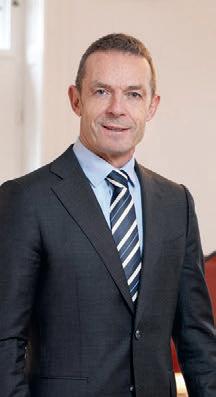
see compilation on pages 10-18
Vince Awards
There were a number of surprises in the audience vote for the Vince Awards for the viticulture industry and its related sectors. This was the first occasion that the Vince Awards were presented to the best representatives of the Hungarian wine scene, dominated by the Villány and Szekszárd regions. Both wine professionals and members of the public were involved in the voting process. see article on page 23
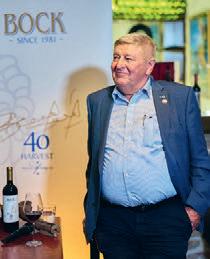
NOVEMBER 2021 HUF 1710 EUR 6 FOCUS country



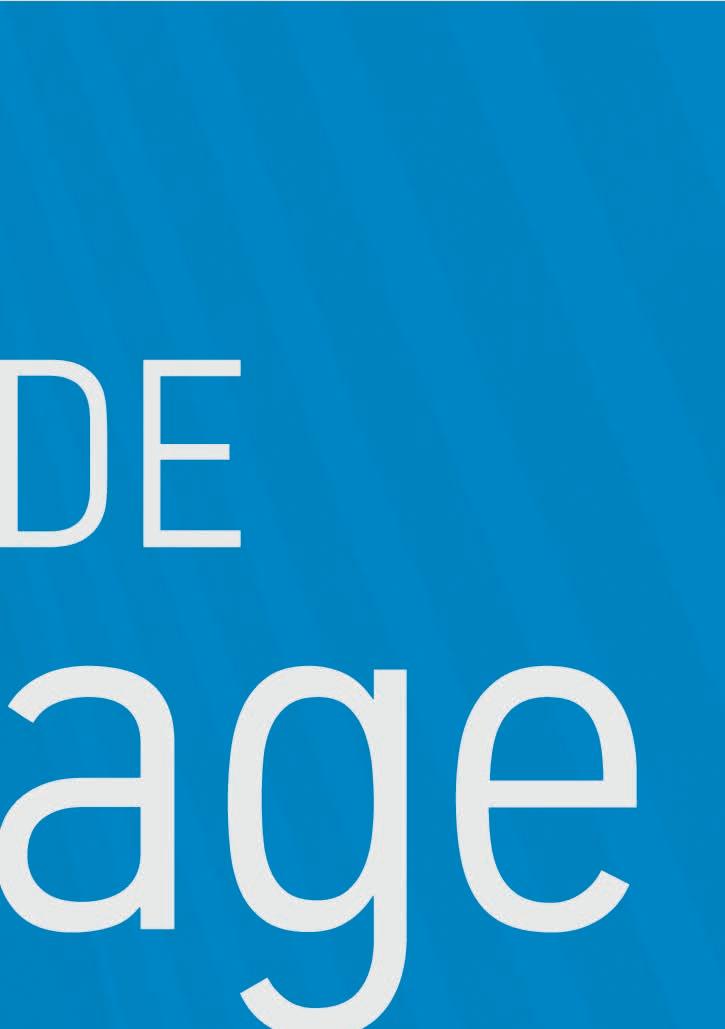













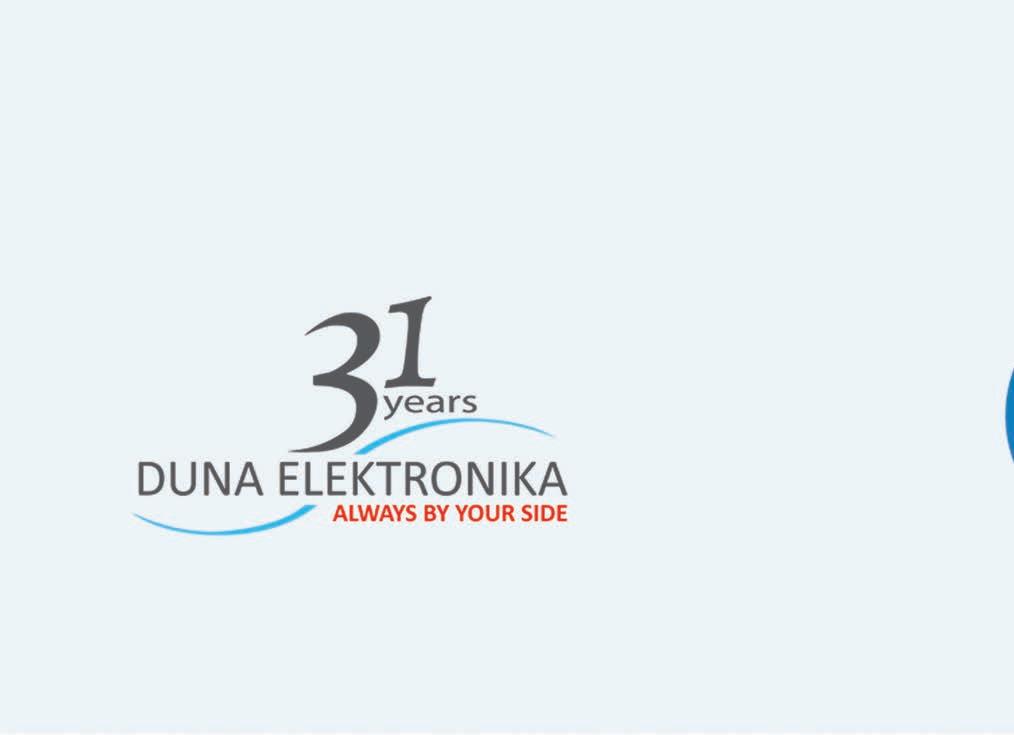




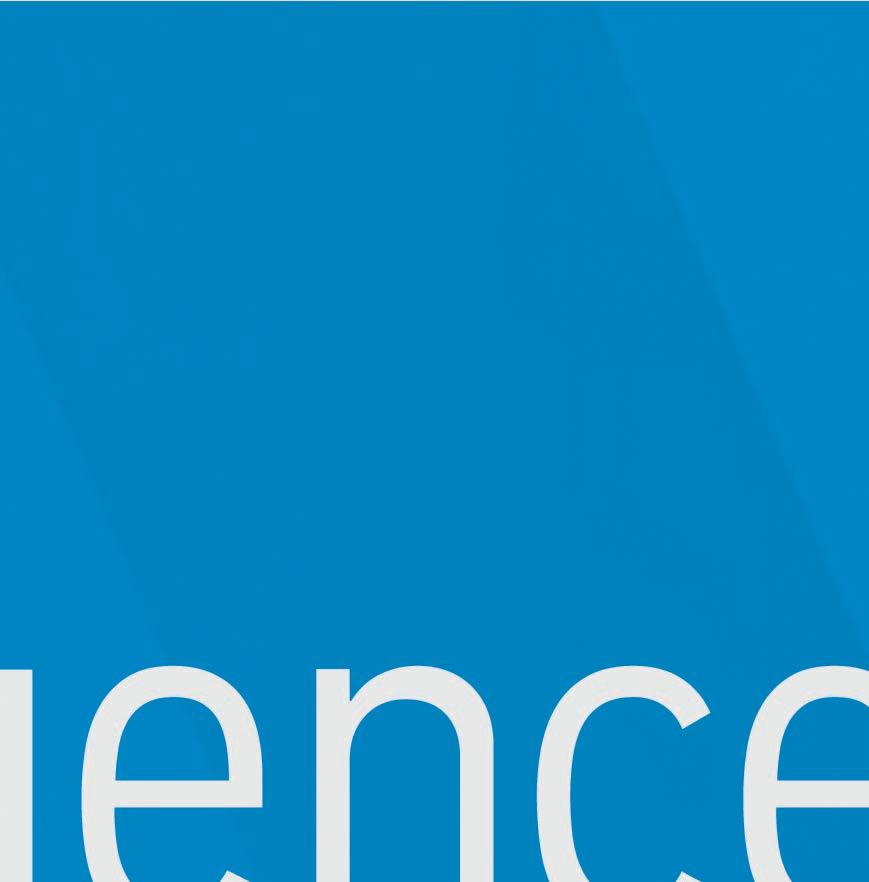

















letter from the publisher
Illegal immigration from Central America to the United States rose tenfold in the past few decades with over three-quarters of these people coming from the Northern Triangle of El Salvador, Guatemala, and Honduras. Our international analyst discusses the well-known 'push factors' and 'pull factors'. Republicans are usually tougher on the basis of the principle of ‘law and order', while Democrats tend to be more permissive. However, this may change with the 2022 elections in mind. Immigration, handling illegal immigrants already in the U.S., border control and related issues also seem to have fallen victim to political struggles.
The country in focus this month is Denmark, the country Hungary has the most outstanding relations with among the north European countries. In addition to the prominent traditional Danish investors, the influx of new investors is continuous. Danish firms and subsidiaries in Hungary employ more than 15,000 people. The Danish ambassador to Hungary, Erik Vilstrup Lorenzen, an expert on European relations, discusses the two countries relationship within the EU and NATO, highlights the importance of public diplomacy “where we talk about our values.” He stresses that there is a greater and greater presence of Danish companies here in Hungary, but there is always room for improvement. Of course, The compilation also includes the presentation of companies that play the most important part in bilateral corporate relations.
As in other countries, one of the sectors most hit by the pandemic is tourism in Hungary as well. Our business page tells you about the initiative of tourism experts to revive – after one and a half years – the annual informal event, T-DAY where professionals of this industry can get together in a relaxed atmosphere to discuss what they can do ‘together for tourism’.
This month, WittyLeaks is authored by the Irish ambassador who has experienced – while visiting various universities in Hungary – that Irish Studies are a great way to build cultural relations and people-to-people links in this country and result in deepening understanding and respect.

As you can find out on our wine page, there were a number of surprises in the audience vote for the recent Vince Awards for the viticulture industry and its related sectors when the winners of the 33 categories were announced.
As the pandemic continues, please, remain vigilant and safe!
Peter Freed PUBLISHER
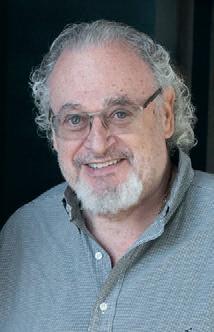
cont en ts
21 WHAT’S ON Concerts, festivals, events and exhibitions in and out of Budapest
08 ANALYSIS
Immigrants massing at the MexicanU.S. border
10-18 DANISH FOCUS
Interview with Ambassador Erik Vilstrup Lorenzen; JYSK; Soft Flow; VELUX; Nilfisk; Noma on top again 20 WITTYLEAKS by the Ambassador of Ireland
PUBLISHER: Peter Freed EDITOR: Sándor Laczkó PHOTO EDITOR: Dávid Harangozó
SALES & MARKETING DIRECTOR: Tamás Varga ADMINISTRATION: Éva Madarász

CONTRIBUTORS: Sándor Laczkó, Tamás Magyarics, Ronan Gargan
PHOTO CONTRIBUTORS: depositphotos.com (cover), Bálint Csizmadia (cover), facebook.com/mindenkimagyar, depositphotos.com, Heineken Hungária, mercedes-benz. com, swisskrono.com, Márton Király/MFAT, Soft Flow, Tamás Bata/batatamas.hu, Ditte Isager, Embassy of Ireland, trilite.hu, Sting, Italian Film Festival - Mittelcinemafest, David T Kindler, Bálint Hirling, Paul Cezanne - Museum of Fine Arts, Vince, Bálint Csizmadia, MTI Photos: Zoltán Balogh, Tamás Kovács, Zoltán Gergely Kelemen, Tamás Vasvári, György Varga, Tibor Rosta.
22 TOURISM
T-DAY – a networking event for tourism professionals

23 WINE
The most popular Hungarian wines in 2021
FRENCH FOCUS – COMING SOON

Diplomacy&Trade is going to present a special Focus section on relations between Hungary and the Republic of France on the occasion of France taking over the Presidency of the Council of the European Union in the first half of 2022. France is the 5th largest investor in Hungary. Just over 700 French-owned registered companies operate in the Hungarian market, employing more than 35,000 people. The leading article of the compilation will be an interview with the French ambassador to Hungary, Pascale Andréani about the main aspects of bilateral relations and also as allies within the European Union and NATO. We also present the activities of the 30-year-old French-Hungarian Chamber of Commerce and Industry (CCIFH) and several of the French ventures operating in Hungary.
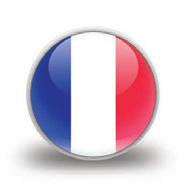
NOVEMBER 2021 |DIPLOMACY & TRADE| www.dteurope.com 4 Copyright 2004-2020 DUAX Kft., all rights reserved | ISSN 1589-8075 This magazine is produced by DUAX Kft. The opinions published in the magazine do not necessarily reflect the opinions of DUAX Kft. photo by BÁLINT HIRLING, TRILITE.HU, DÁVID HARANGOZÓ, DEPOSITPHOTOS.COM We welcome inquires for advertising in this issue. PLEASE CALL TAMÁS VARGA FOR FURTHER INFORMATION +36 209 350 250 - tvarga@budapestweek.com AND DON’T FORGET monthly in print - daily on the web www.dteurope.com COPIES ARE AVAILABLE AT SELECTED RELAY AND INMEDIO OUTLETS IN MAJOR HUNGARIAN CITIES. NEWSSTAND PRICE: HUF 1,710 or EUR 6 - Subscriptions are available for an annual fee of EUR 72 in Hungary, or EUR 90 to all other destinations. SEND REQUESTS AND INQUIRIES TO DUAX KFT. H-1034 Budapest, Bécsi út 60. TELEPHONE [+36-70] 320-3051 | FAX [+36-1] 350-5660 E-MAIL editor@dteurope.com | ADVERTISING tvarga@budapestweek.com 05 ON THE RECORD 06-07 COMPANY BRIEFS
page 22
Putting spirit into the tourism profession
20
Irish studies at Hungarian universities page
Event guide to the Hungarian capital page 21
NATIONAL HOLIDAY IN THE SPIRIT OF NEXT YEAR'S ELECTIONS
October 23 is a national holiday in remembrance of the outbreak of the uprising against the Stalinist style regime on this day in 1956 and the ensuing revolution. Speakers at different rallies used the occasion to speak to their supporters with view to the parliamentary elections due next spring.
Prime Minister Viktor Orbán, President of the ruling Fidesz party, wasted little time talking about the revolutionary events of 65 years ago, but spoke rather about the events of 15 years ago. In 2006, police were needed to control the rioting protesters who had also invaded the headquarters of Hungarian Television. In Viktor Orbán's interpretation, "in this place where we are standing, 15 years ago, the streets were covered with violence, blood and tears, we will never forget them".
In his speech, Orbán also compared Ferenc Gyurcsány, who was prime minister in 2006, to the wolf in sheep's clothing. According to Orbán, the left is now "plotting and scheming." The prime minister claimed that it has been his government in the past 11 years that helped Hungary recover from the destruction of the country by left-wing governments before 2010. The other major speaker of the day was opposition prime ministerial candidate for next year's parliamentary elections, Péter Márky-Zay. He began his speech by saying that Hungarians in 1956 were fed up with wiretapping, surveillance, mock-up trials, Russian influence, and – referring to present-day politics – he said "we have had enough of that now". Later, he spoke about the revolution of the little ones, about accountability, and he said that the only question at the elections will be “Fidesz or not Fidesz.”
on the record
parliamentary elections, with the joint opposition candidate for prime minister and individual MPs being elected in a primary election.
In the first round of the primaries, the highest number of votes was cast for Klára Dobrev. Budapest mayor Gergely Karácsony, the candidate of MSZP, Párbeszéd and LMP, came second, while Péter Márki-Zay came third with 123,453 votes (20.02%). In the second round, only two candidates took part, as the mayor withdrew.

UPCOMING NATIONAL DAYS
OPPOSITION CHOOSES TOP CANDIDATE FOR 2022 ELECTIONS
Péter Márki-Zay won the opposition primary election for prime minister this October. The mayor of the southeastern Hungarian town of Hódmezővásárhely, President of the All Hungary Movement received 56.71% of the votes, while his opponent, Klára Dobrev, Member of the European Parliament for the Democratic Coalition (DK) party, received 43.29%.
In the second round to decide who will lead the unified opposition against the currently ruling Fidesz party in the parliamentary elections expected to be held in the spring of 2022, 662,353 people participated in person or online.
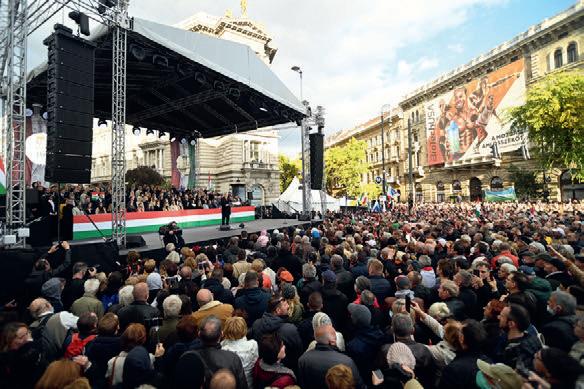
Six opposition parties (DK, Jobbik, LMP, Momentum, MSZP and Párbeszéd) had decided to run jointly in the 2022
MASK WEARING COMPULSORY, EMPLOYEE VACCINATION MANDATORY
As of November 1, the wearing of a face mask is again required on public transport, and employers may require their employees to be vaccinated to increase vaccination coverage. In the public sector, vaccination is mandatory, while in municipalities it is up to the mayors to decide. The relevant government decree states that masks have to be worn on public transport, at stations and stops, as previously. Children under the age of six years, people with intellectual or psychosocial disabilities and people with autism spectrum disorders are exempted from wearing masks.
To increase vaccination coverage and protect workplaces, the government will allow employers to require their employees to be vaccinated against coronavirus as a condition of employment, either as a standard working condition for all employees or as an individual working condition, depending on the job.

For workers who have not yet been vaccinated, employers may set a 45-day deadline for the first vaccination. If the worker fails to take the vaccination within the time limit set by the employer, the employer may order unpaid leave and, if the worker still fails to take the vaccination within one year, may terminate his/her employment with immediate effect by dismissal or resignation.
KYRGYZSTAN OPENS EMBASSY IN BUDAPEST
The Hungarian Minister of Foreign Affairs and Trade Péter Szijjártó and Kyrgyz Foreign Minister Ruslan Kazakbayev jointly opened the Embassy of Kyrgyzstan in Budapest this October.
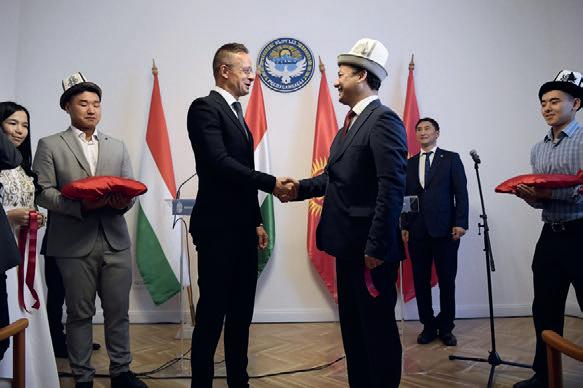
December
In the context of the relations between Hungary and Kyrgyzstan, the Hungarian minister said it was important that there were no outstanding political issues between the two governments and that the reciprocal opening of the embassies meant that personal presence was already a given.
He also mentioned the stable financial background: a financial fund has been established to support bilateral trade. He said that with a huge oversubscription, 150 Kyrgyz students arrive in Hungary on scholarships every year.
Together with his Kyrgyz counterpart, the minister also attended the celebration of the Day of Turkic Cooperation and Unity at the Turkic Council's representative office in Budapest.
WORLD-RENOWNED HUNGARIAN ECONOMIST, 94, PASSES AWAY
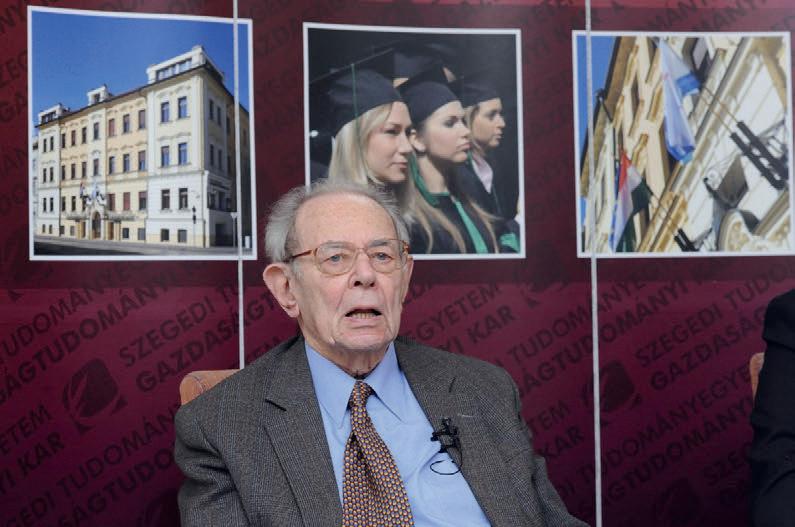
János Kornai, Széchenyi Prize-winning economist, member of the Hungarian Academy of Sciences, professor emeritus at Harvard University and Corvinus University, recipient of the French Order of Honor, honorary member of the Swedish, American and other academies, passed away in the middle of October in the 94th year of his life.
János Kornai was born in 1928 in Budapest. He graduated from the Budapest University of Sciences, was the economic editor of the daily Szabad Nép from 1947 and became a staff member of the Institute of Economics of the Hungarian Academy of Sciences in 1955. In 1966, he was awarded the title of Doctor of Economic Sciences, in 1976 he was elected a Corresponding Member of the Hungarian Academy of Sciences and in 1982 a Full Member.
He was invited to be a visiting professor by several foreign universities: the University of Sussex in 1966, Stanford in 1968 and 1973, Yale in 1970, Princeton in 1972 and 1983, Stockholm in 1976-77 and Harvard in 1984-85. He was Vice-Chairman of the United Nations Development Planning Commission from 1972 to 1977.
He served as Head of the Department of Economics at the Institute of Economics of the Hungarian Academy of Sciences, and was also a professor at the Collegium Budapest, the Budapest University of Economics and Business, and from 1986 at Harvard University in the USA.
His main research interests were mathematical methods of design, the economic application of mathematics and computer science, and the theory of economic mechanisms. His works on economics are available in ten languages. His best-known work is ‘The Deficit’, published in 1980.
www.dteurope.com |DIPLOMACY & TRADE| NOVEMBER 2021 5 photo by ZOLTÁN BALOGH/MTI, FACEBOOK.COM/MINDENKIMAGYAR, DEPOSITPHOTOS.COM, TAMÁS KOVÁCS/MTI, ZOLTÁN GERGELY KELEMEN/MTI
1Algeria National day 11Poland Independence day 11Angola Independence day 15Belgium National day 18Latvia Independence day 18Morocco National day 19Oman National day
Independence day 28Albania Independence day
November
22Lebanon
1Romania National day 2 Laos National day 2UAE National day 5Thailand National day 6Finland National day 12Kenya Independence day 13Malta National day
Independence day 16Bahrain Independence day 18Qatar National day 24Libya Independence day 29Mongolia Independence day
16Kazakhstan
company briefs
THYSSENKRUPP: NEW R&D COMPETENCE CENTER IN BUDAPEST
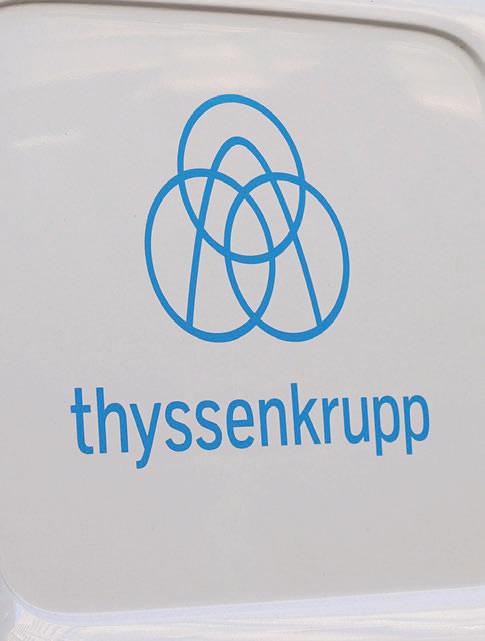
Opened this October, the new office building, which was created from EUR 6.2 million, comprising 13,200 square meters of office space and a 2,500-square-meter laboratory complex, provides space for 1,200 workstations. The German-owned company currently employs more than 1,000 highly qualified engineers at its headquarters in Budapest.
Thyssenkrupp is one of the world's top component suppliers whose clientele covers almost all large car manufacturers. Nine out of ten premium category cars contain the company's products. Thyssenkrupp gear components are present in every third truck, and the company is leader in automotive digitalization and development.
The giant company started developing electric steering systems in Hungary in 1999. Electromechanical power steering systems, which can cooperate with a variety of driver assistance and self-driving systems, are developed at their competence center in Budapest. This center is considered one of the best in the world in its own competence area. The development of the office and laboratory complex shows Thyssenkrupp's long-term commitment to Budapest in the field of research and development of electromobility.
The new office infrastructure was designed to fully serve the future-oriented, so-called agile project management, in the company's case the software and hardware R&D activity.
The special laboratory infrastructure was integrated into office environment, thereby supporting efficient development activity. The lab and test equipment can be controlled remotely, thus they are suitable for remote working, a major part of which was designed by the company's own E/E (electric and electronic) team, the Hungarian Investment Promotion Agency reports.
HEINEKEN TURNS BEER CONSUMPTION GREEN
HEINEKEN Hungária says it is still leading the way in sustainability goals and their fulfilment. The company was the first global beer company to remove PET packaging from its portfolio and, reacting to consumers’ demands, switched to paper cups before the regulations enforcing the move came into effect. According to plan, they will switch to carbon neutral production by 2030 and the company’s entire supply chain is expected to emit zero harmful gases by 2040. In 2018, HEINEKEN Hungária was the first company to launch a campaign raising awareness of the importance of the kinds of cups and bottles consumers drink their beers from. Among the large beer brewers on the market, HEINEKEN Hungária was once again the first to remove PET packaging from its portfolio, saving the environment from 200 tons of plastic annually. Starting from this year on, the company has been producing and distributing beer in glass, beer kegs or aluminum that can be reused an infinite number of times. The company has been decreasing its waste and plastic production since 2019. Switching from plastic cups to ecologically degradable paper cups that the company procured from a local supplier was a significant step forward, driven by consumer demand. The raw material used is made exclusively of primary fibers, without chemical processes, and is free of any contaminants, so the cardboard and its coating can be composted and recycled. When selecting the paper cup material for replacing plastic ones, HEINEKEN Hungária paid attention not only to minimizing the materials’ environmental impact and choosing a local supplier, but also sought to make sure that drinking beer remains the same enjoyable experience that consumers and partners were used to. The paper cup designed especially for HEINEKEN has enough room for the beer head and the
LIDL: HUNGARY'S LEADING WINE EXPORTER
Lidl Hungary set a record last year, both at home and abroad, selling 28.5 million bottles of Hungarian wine in 2020, a 21% increase compared to the previous year. By selling HUF 6.3 billion worth of domestic wine to foreign markets, the discount chain accounted for 33% of total Hungarian wine exports in bottles, thus confirming its position as the largest domestic wine exporter, index.hu reported.
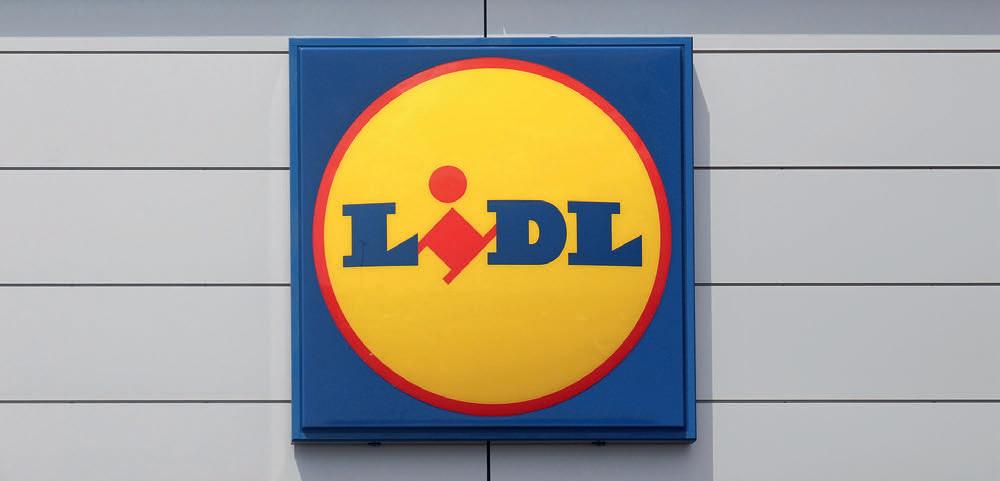
For years, the supermarket chain has been striving to support Hungarian suppliers, which is why it launched a program for them back in 2013. As part of this initiative, Lidl Wine Expo Hungary was launched in 2014 with a special focus on improving the position of Hungarian wineries and promoting Hungarian wines. The program has proved so successful that while in 2014 the company sold six million bottles at home and abroad, by 2020,
this figure reached 28.5 million, a 21% increase on the previous year. “2018 was the turning point for Lidl Hungary to become the largest domestic wine exporter with 11 million bottles. In 2020, we passed the 15 million bottle mark, which is a clear success not only for us, but also for the Hungarian wineries,” Judit Tőzsér, Lidl Hungary's corporate communications manager, told index.hu. The company exported 195 types of domestic wine to twelve countries across Europe, with Germany, the UK and the Czech Republic being the three largest markets. The most popular wine varieties were Szürkebarát, Királyleányka, Egri bikavér, Tokaj Furmint and Irsai Olivér.
Lidl's Hungarian stores also sold more wine than in previous years, with a more modest increase, but the 13.2 million bottles sold were still the highest ever in the history of the discount chain.
marking of the gauge is clearly visible not only on the outside but also on the inside of the cup – to the delight of bartenders. The manufacturer was also careful to use the paper cups as a communication platform and thus had speech bubbles printed on them conveying various messages about sustainability. Initially, HEINEKEN Hungária plans to introduce paper cups in 1,000 HoReCa units across the country. So far, 13,000 of HEINEKEN Hungária partners expressed their will to use the new paper cups. Based on the precontracts made, HoReCa units will soon receive nearly three million paper cups countrywide, of which 850,000 have already been delivered to about 450 partners of HEINEKEN Hungária. Thanks to the improved distribution system and a more responsible waste management, these three million paper cups will be suitable to replace 10 million plastic cups.
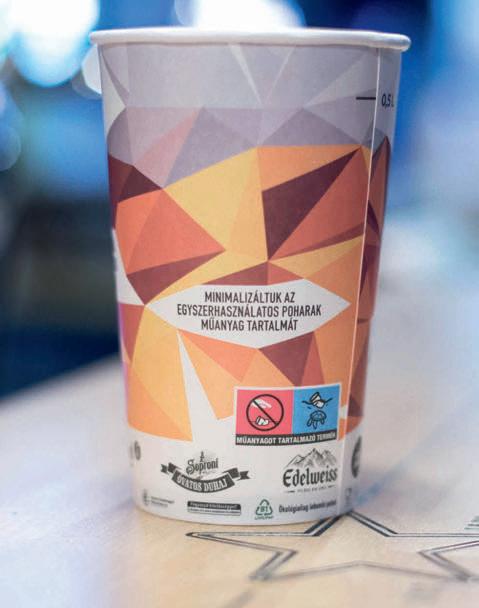
A solar farm was inaugurated this October in Öskü, Veszprém county in western Hungary. The tenmegawatt power plant will provide electricity for more than five thousand families.
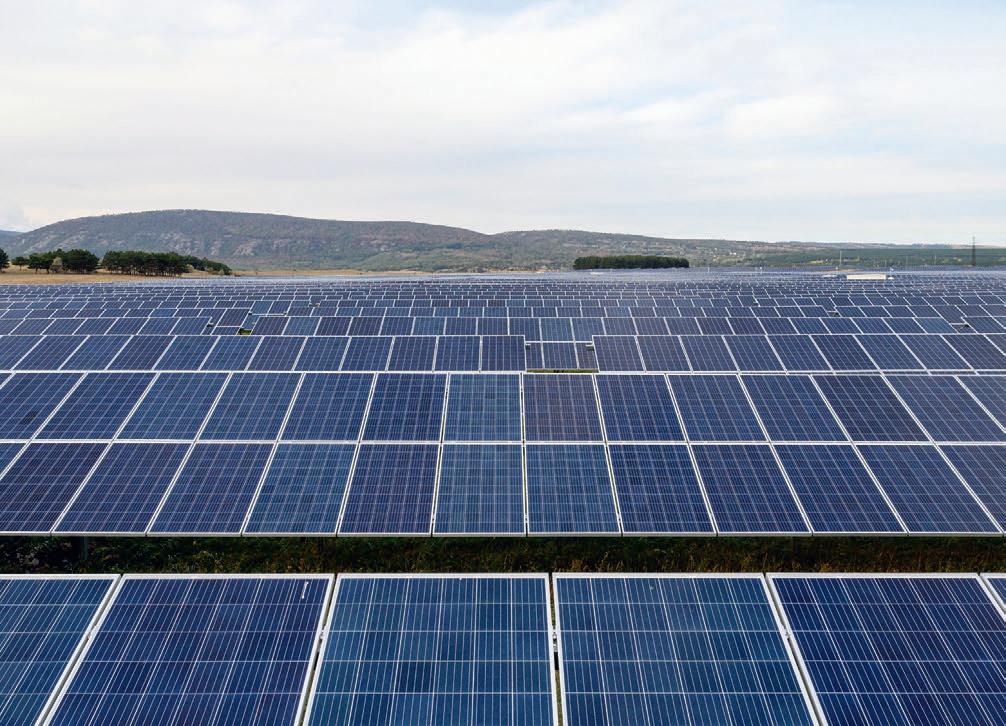
Attila Steiner, Minister of State for the Development of the Circular Economy, Energy and Climate Policy of the Ministry of Innovation and Technology, stressed at the inauguration ceremony that the government has set a target of 90% of electricity generation without carbon dioxide emissions by 2030, and the realization of solar parks is a significant step towards this goal.
Attila Steiner highlighted that the total solar capacity in Hungary is currently 2,300 megawatts, which is more than the capacity of the Paks nuclear power plant. The goal is to triple this capacity by 2030, he added. Ernő Kiss, President of the Hungarian Solar Panel Solar Collector Association and Managing Director of the investor Greentechnic Hungary Ltd, said the solar farm in Öskü, which covers 20 hectares, will supply energy to the residents of the area for 25 years.
6
SOLAR PANEL PARK INAUGURATED IN ÖSKÜ
photo by DEPOSITPHOTOS.COM, HEINEKEN HUNGÁRIA, TAMÁS VASVÁRI/MTI
NOVEMBER 2021 |DIPLOMACY & TRADE| www.dteurope.com
company briefs

TWO NEW EGIS PLANTS IN KÖRMEND



In order to increase their pharmaceutical production capacity, French-owned Egis Pharmaceuticals has expanded its site in Körmend, W Hungary. With the investment of more than EUR 21.8 million, in addition to the new packaging factory, Egis has also established a plant with special know-how and technological needs, typically suitable for the production of oncology products; thereby, it is able to implement all pharmaceutical processes in the field of oncology products from developing to manufacturing active ingredients and finished products in-house.



The Servier Group is the second largest pharmaceutical group in France. They have 16 manufacturing bases, 15 international therapy research centers and five research and development (R&D) centers worldwide, while their products are available in 150 countries.

MERCEDES TO MANUFACTURE A PURELY ELECTRIC VEHICLE IN HUNGARY

Mercedes-Benz Manufacturing Hungary launches the series production of its new fully electric SUV model, the 'EQB'. The company completed the investment in a remarkably short period of time from decision-making – in less than one year.

Egis' product portfolio consists of more than 600 products in total. Their main therapeutic areas are the cardiovascular and central nervous system, while they also offer advanced therapeutic options with oncology and gynecological preparations. Besides Hungary, Egis sells its products under Egis' brand names in 17 countries through its network of subsidiaries and representative offices, while its product range is available in 60 countries, in total.

NATURTEX EXPANDS PRODUCTION CAPACITY IN SZEGED


The new production hall and office building of the Hungarian family-owned textile manufacturing Naturtex Group was completed in the southeastern Hungarian city of Szeged this October. With an investment of almost EUR 12 million (over one third which is paid for by Hungarian taxpayers through a government decision) creating 150 new jobs, the company achieves a significant capacity increase, furthermore, it can ensure efficient and sustainable production in the long-term by applying state-of-the-art technologies.
Launched in 1989, Naturtex owns a 1,700-piece product range, including duvets, bedding linens and bathroom textiles, and has become market leader in Hungary, exporting their products to more than 40 countries around the world. The company's 2020 turnover was close to HUF 7.5 billion, the export ratio of which represented 85%.
Naturtex has developed its own automated feather recycling technology, for which they purchased a plant hall with more than 4,500 square meters, housing cutting edge machinery currently available in the world market. Its subsidiary, NTT Manufacturing Ltd. has built a brand-new production hall of 7,000 square meters, as well as implemented the acquisition of the technology needed to produce filled bed textiles. Thanks to the investments, the total production capacity of Naturtex has increased by almost 40%.
EQB is the very first fully electric vehicle to be manufactured in series production in Hungary. The purely electric compact SUV model, which can be ordered as a 7-seater as well, will be exported by Mercedes from Hungary to all countries of the world, except the Chinese market. The overall value of the investment is more than EUR 100 million. The planned start date for production, based on the existing infrastructure, is the last quarter of 2021. The integration of the new model into current series production is made possible by flexible and efficient processes. The assembly lines of the MercedesBenz plant in Kecskemét will manufacture all drive types from the classic internal combustion engines through the plug-in hybrids to the purely electric drive. Like other Mercedes-Benz electric models, the EQB will be produced on the same production line at the Kecskemét plant as the conventional and hybrid drive models.
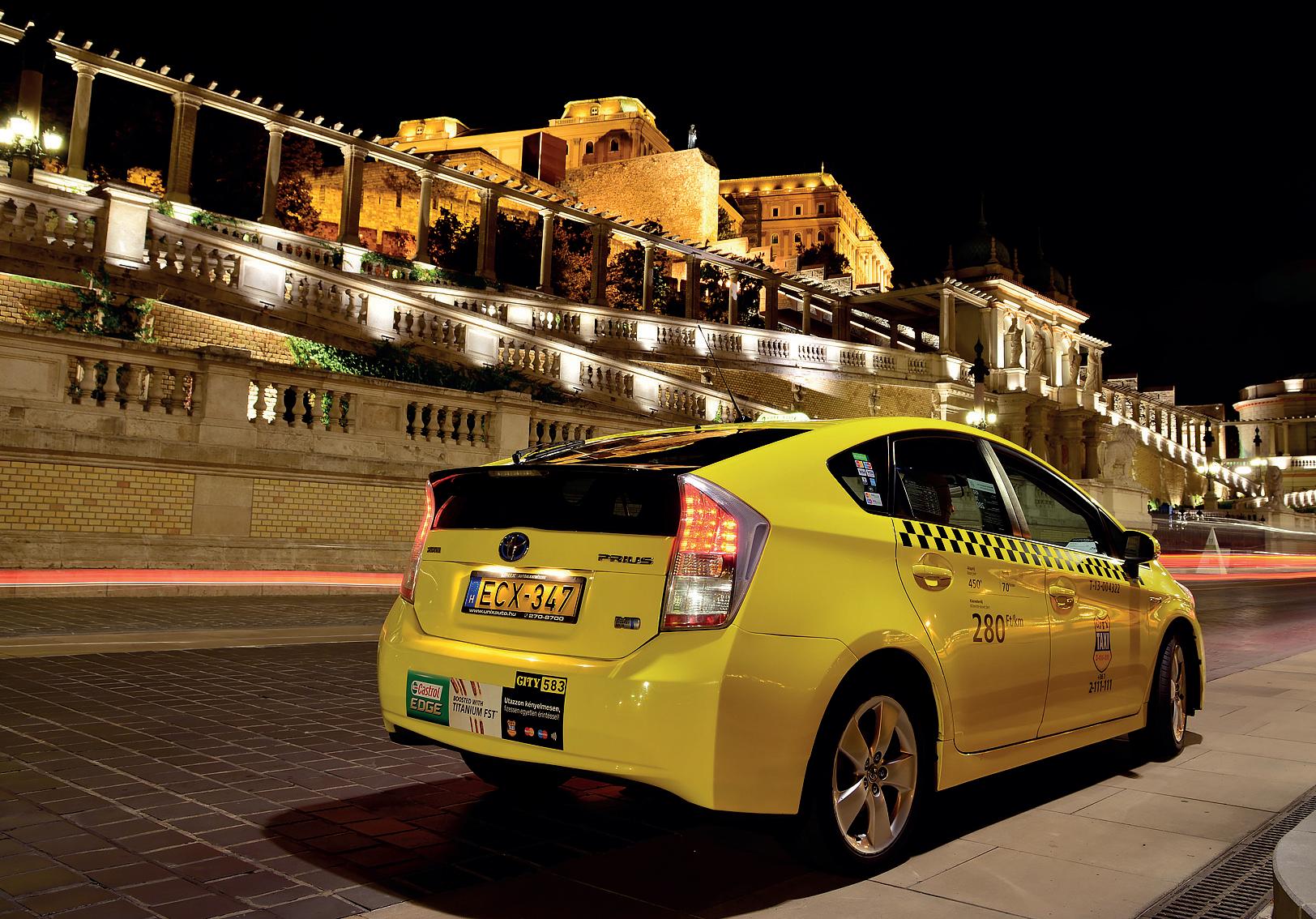

SWISS KRONO CAPACITY INCREASE IN VÁSÁROSNAMÉNY





Swiss-owned Swiss Krono, the world's leading manufacturer of wood-based materials, has decided to implement a significant capacity increasing development in Hungary. As a result of the investment of EUR 47 million retaining 145 jobs and creating 28 new ones, the ‘OSB’ (Oriented Strand Board) production capacity of the Vásárosnamény plant will increase more than 1.5 times. About 15% of the investment cost is borne by Hungarian taxpayers as a result of a government decision. Swiss Krono, a family business based in Lucerne, currently operates ten factories in eight countries employing some 5,000 people worldwide. About 30% of the planned excess volume will be sold on the Hungarian market, while 70% will be exported. The company is going to expand its special 28.8-meter OSB production line to 38.7 meters and implement the procurement of wood shredding and drying units, as well as related energetic development.

www.dteurope.com |DIPLOMACY & TRADE| NOVEMBER 2021 7 photo by GYÖRGY VARGA/MTI, TIBOR ROSTA/MTI, MERCEDES-BENZ.COM, SWISSKRONO.COM
C M Y CM MY CY CMY K
AND STILL, THEY COME…

TO




















































































 BY TAMÁS MAGYARICS
BY TAMÁS MAGYARICS
”Do not come. Do not come. The United States will continue to enforce our laws and secure our borders” – thus spake Vice President Kamala Harris while visiting Central America. But they have continued to come. Illegal immigration from Central America to the U.S. rose tenfold in the past few decades from an annual 354,000 in 1980 to 3,782,000 in 2019. More than three-quarters of them came from the Northern Triangle of El Salvador, Guatemala, and Honduras.
Root causes






























If we discuss immigrations, we generally make a distinction between the push factors and the pull factors. Both sets are quite well-known to the outside world. As for the former ones, the most frequently mentioned root causes are as follows: poverty, violence and corruption. These are ‘home-grown’ problems, and the key question is how they can be handled. It is usually a wellintentioned – or less well-intentioned – U.S. program that has tried to offer remedies. One can go back to William H. Taft’s ‘dollar diplomacy’ in the early 20th century, but what most likely comes to one’s mind is John F. Kennedy’s Alliance for Progress in the 1960s. The idea was to offer, among others, an alternative to Marxism, which had become quite fashionable in Latin America with the success of Fidel Castro’s revolution in Cuba. Since then, such other U.S. government programs as the Agency for International Development (USAID), as well as international financial institutions under U.S. auspices have been trying to offer medicines, including foreign investment, sometimes supported by military














force, to the countries in the region – some of them have proved to be no more than snake oil. The Obama administration came up with the idea of an Alliance for Prosperity. President Biden’s idea is a ’Plan to Build Security and Prosperity in Partnership with the People of Central America’ – it is too early to say whether it will turn out to be a success or a failure. Some observers, however, claim that it is precisely the U.S. involvement and domination that is at the root of the problems; the ‘one size fits all’ IMF and other approaches do not take local special conditions into account to the extent they should have been. All in all, the decade- or century-long push factors are still there, especially in Central America, where – for instance – education standards are lower if compared to the other countries of origins of immigration to the U.S.
More permissive Democrats
The pull factors are also too well-known to discuss them in detail: higher wages, higher living standard, better education for the children of even those who are staying in the U.S. illegally, more secure environment (despite the less than safe inner-city neighborhoods in the big cities and the intra-ethnic violence). In terms of the U.S. states that are the most popular destinations of the Central American immigrants, it is California, Texas, Florida and New York that are on top; while the highest metro concentrations of Central American migrants can be found in Los Angeles (16% of the total), New York City (11%) and Washington, D.C. (9%). In reality, 1,7 million migrants entered the U.S. in the past 12 months; the highest number annually over more than 50 years. The other side of the coin is that the successive U.S. administrations have tried
to stem the tide of illegal immigration into the country by, among others, deporting hundreds of thousands of illegals back to their mother country annually, strengthening border control, including constructing and reinforcing the border protection facilities. Nevertheless, there are differences of handling the problems related to illegal immigration between the two major parties. In general, the Republicans attempt to apply stricter border checks on the basis of the principle of ‘law and order’, while the Democrats tend to be more permissive. Thus, among others, the Trump administration continued the construction of ‘a wall’ on the U.S.-Mexican border; the Biden administration suspended these efforts. The Trump administration introduced the Migration Protection Protocol (a.k.a. ‘Remain in Mexico’); the Biden administration terminated it. A legal battle has been started by Texas and Missouri, and as things are standing in late October 2021, the Biden administration has to reintroduce the Protocol under a court order. The Trump administration, and the Republicans in general, are opposed to the so-called sanctuary cities, which – almost exclusively under Democratic leadership – are reluctant to enforce federal immigration laws, while the Obama and Biden administrations tolerated –and tolerate – or even encourage outright such municipal policies. President Biden also issued an executive order to reaffirm protection for DACA (Deferred Action for Childhood Arrivals) recipients, while Secretary of Homeland Security Alejandro Mayorkas reigned in the deportation practices of the Immigration and Customs Enforcement (ICE) – the organization was a favorite target of the Democrats during the presidential campaign in 2020 too. Most recently,
the Biden administration has changed some provisions in the so-called Title 42 measure, which established holding facilities for Central American immigrants under the previous administration ostensibly for keeping people infected with COVID-19 out of the country.
With the 2022 elections in mind

The last time U.S. Congress had passed a comprehensive immigration act settling the issue of some 11 million illegals in the country was in 1986. These were good old times: bipartisan cooperation was not a curse word among either the Democrats or the Republicans. Nowadays, political polarization has reached new heights in recent times. As then Republican Senate Majority Leader put it after the congressional elections in 2010: their sole goal would be to make Barack Obama a one-term President. The same could have been said by Democratic Speaker Nancy Pelosi in 2019 as well. 2022 is a congressional election year; any major – and even minor – piece of legislation is a political football between the two parties, whose only concern seems to hurt the opponents as much as possible with less or no regard to a number of pressing problems facing the country. Immigration, handling illegal immigrants already in the U.S., border control and related issues also seem to have fallen victim to political struggles. The political, economic, social, and security situation in the Central American states are not likely to improve either. The issue referred to in the subtitle of this article is bound to be as relevant in the coming years as it is today.
Tamás Magyarics
is a foreign policy analyst



















































NOVEMBER 2021 |DIPLOMACY & TRADE| www.dteurope.com analysis 8 illustration by DEPOSITPHOTOS.COM
ADMIT MORE ILLEGAL
IMMIGRANTS, OR NOT TO ADMIT MORE ILLEGAL IMMIGRANTS…











































TAKENAKA EUROPE GmbH HUNGARY BRANCH OFFICE Architecture / Engineering / Construction www.takenaka.eu info@takenaka.hu
ASPIRING TO FINE FORM for a future generation
BY SÁNDOR LACZKÓ
Ambassador Lorenzen arrived to Hungary over a year ago. Concerning his plans and how much he has been able to realize under these difficult circumstances, he tells Diplomacy&Trade that “I was very pleased to come to Hungary, partly because of my background. My strong side is working on European issues. I have worked in Copenhagen with the European Union, including, for instance, on the EU enlargement at the time when Hungary became a member country – a process, which culminated in the new member states signing the enlargement document in 2004 in Copenhagen. I have been posted in Brussels, in London and in Rome and in Canada. For me, it is a big privilege to represent my country in Hungary.
Public diplomacy

He adds that there's another task, which is very important here and that is public diplomacy “where we talk about our values – we do that together with the Nordics. We have a lot of cultural events. Of course, there's been some restrictions on that
TWO COUNTRIES WORKING CLOSELY TOGETHER
during the coronavirus epidemic. But we managed to hold the Nordic Night with cultural events around Budapest. Next year, we will try to hold one on the Danish diplomat of tragic fate, Povl Bang-Jensen with experts also coming from Copenhagen. So, there's a lot of cultural ties with a lot of Hungarians going to Denmark, and a lot of Danes coming here. I was very pleased to see how vivid and alive culture here is. I'm impressed by that. Also, therefore there is big cultural exchange.”
When it comes to cultural and public diplomacy, the Embassy started together with the Nordics what they call Nordic Bridge. It is a series of events run and hosted by the Nordic Embassies in Budapest covering a spectrum of topics selected and shaped in collaboration with the members of the local community, that of about 40 young Hungarian professionals, prospective leaders from different walks of life, representing business, culture, sport, science and education, civil society and media. Nordic Bridge is about openness and trust and it aims at providing information, sharing ideas and best practices from Hungary and the Nordic countries, mixing valuable expertise and experience through dialog
and exchange, and contributing to an informed debate on Nordic strengths, achievements and values, Ambassador Lorenzen explains.
Trade relations
The third angle is the trade side, he says. The volume of bilateral trade is over EUR one billion per
year. There are about 70 Danish companies here (employing over 15,000 people in Hungary) with a significant amount of investment. After the earlier years dominated by manufacturing investments, recently it is R&D and technology investments that have been added and new functions have emerged (back-office functions and logistics centers at
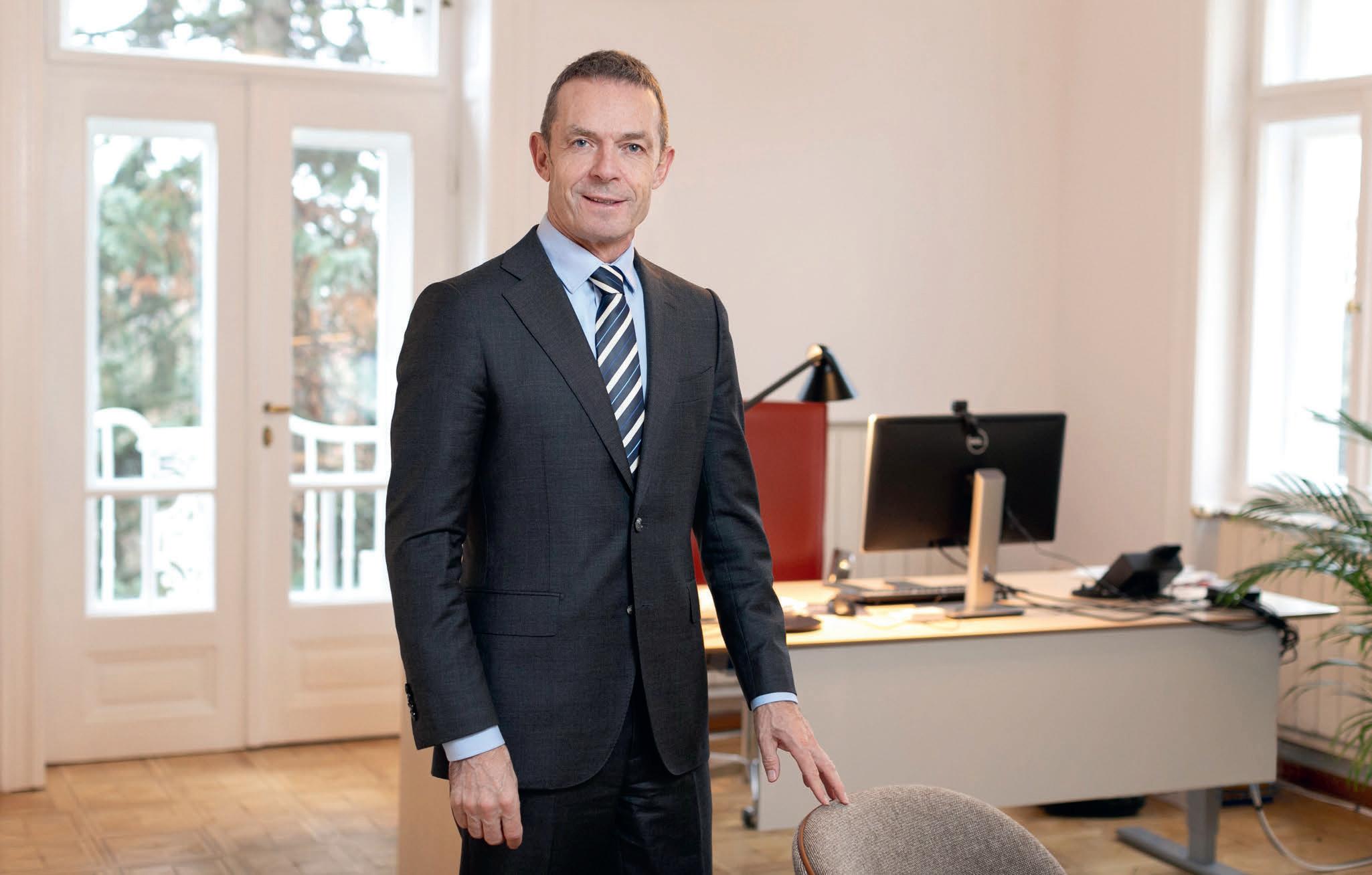

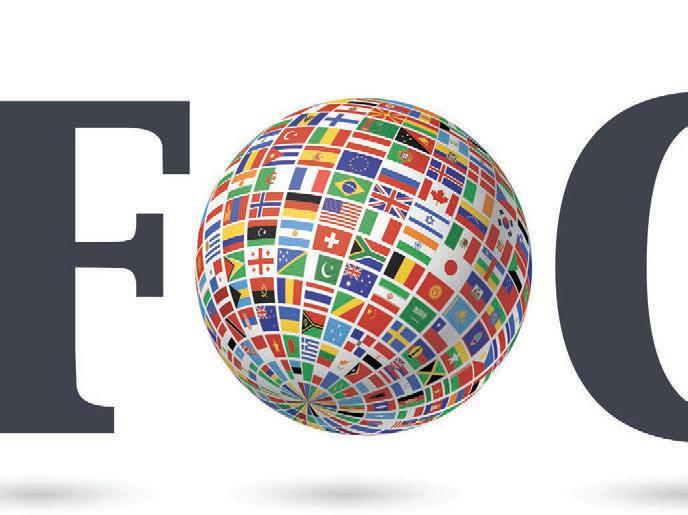
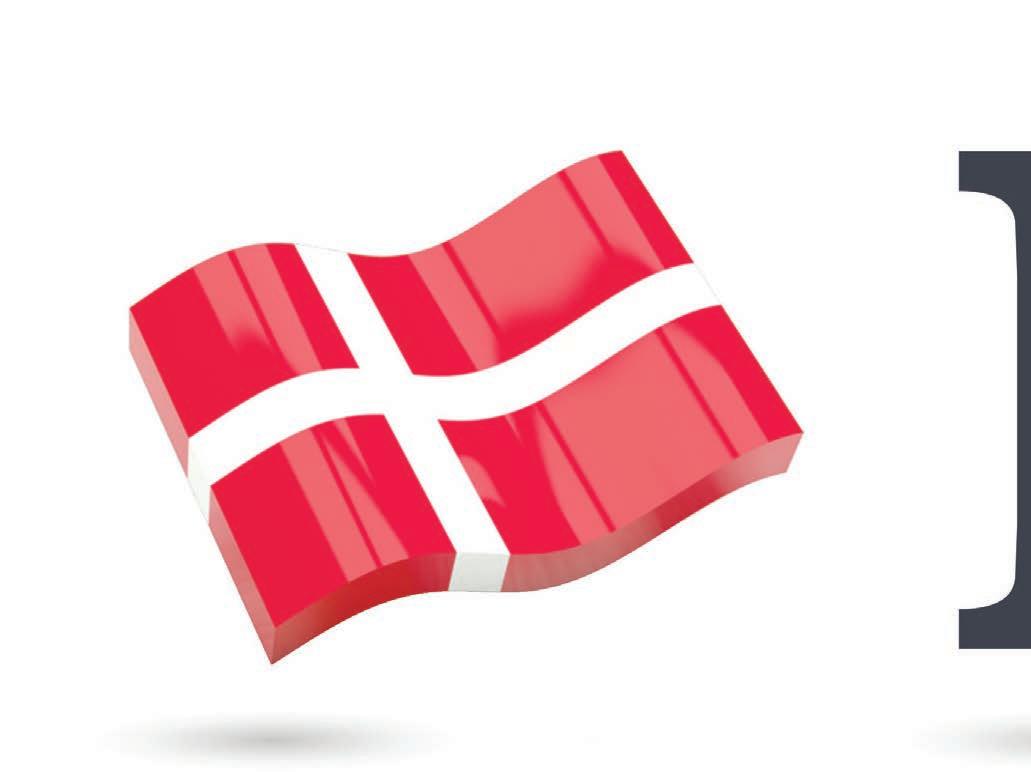
NOVEMBER 2021 |DIPLOMACY & TRADE| www.dteurope.com 10 photo by DÁVID HARANGOZÓ, DEPOSITPHOTOS.COM
INTERVIEW WITH THE AMBASSADOR OF DENMARK, ERIK VILSTRUP LORENZEN HUNGARY DENMARK AREA 93,028 sq km 43,094 sq km country comparison to the world 110 133 POPULATION 9,728,337 (July 2021 est.) 5,894,687 (July 2021 est.) country comparison to the world 93 113 POPULATION GROWTH RATE -0.29% (2021 est.) 0.44% (2021 est.) country comparison to the world 215 159 BIRTH RATE 8.72 births/1,000 population (2021 est.) 11.17 births/1,000 population (2021 est.) country comparison to the world 209 171 LIFE EXPECTANCY AT BIRTH 73.27 years 81.45 years country comparison to the world 91 35 NET MIGRATION RATE 1.24 migrant(s)/1,000 population (2021 est.) 2.74 migrant(s)/1,000 population (2021 est.) country comparison to the world 57 39 GDP - PER CAPITA (PPP) USD 31,000 (2020 est.) USD 55,900 (2020 est.) country comparison to the world 63 20 UNEMPLOYMENT RATE 3.45% (2019 est.) 3.05% (2019 est.) country comparison to the world 48 40 TELEPHONES - MOBILE/CELLULAR 10,332,660 (2020) 7,243,465 country comparison to the world 87 106 AIRPORTS 41 (2013) 80 (2013) country comparison to the world 103 68 Source: World Factbook
danish focus
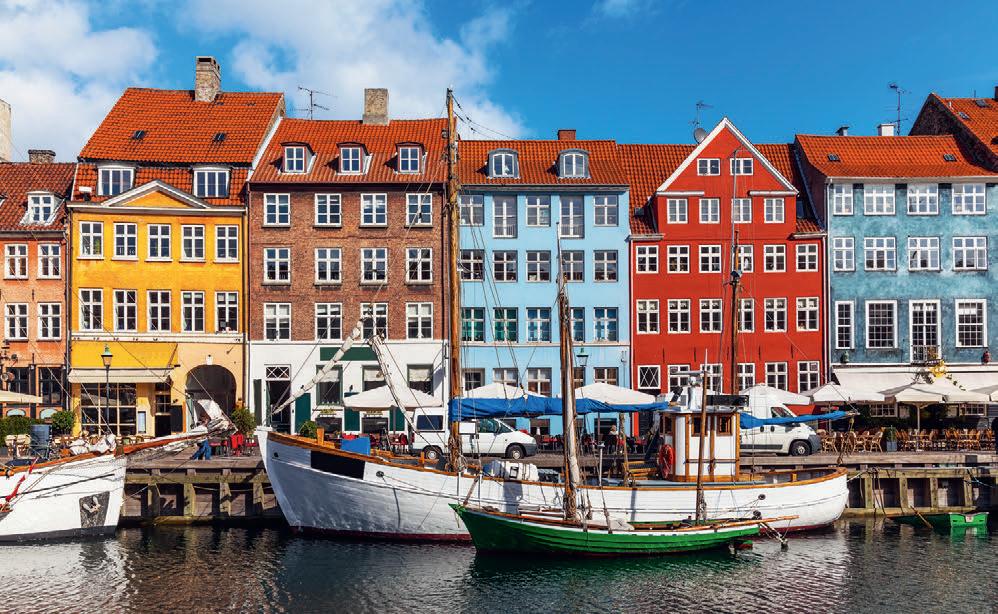
regional level). “Some of these companies are newcomers while others have been here for a while like Grundfos that celebrates 25 years in this country or Velux that has been here for 35 years. The latter is going to open a regional center in Budapest soon. This November saw a huge investment by Soft Flow, which was acquired five years ago by the Danish company FOSS, and we have others are also expanding. We work quite closely with the companies regarding the new coronavirus epidemic, for instance: how the closure affects them, if you have a lockdown on schools and parents have to stay at home, etc.” There is a greater and greater presence of Danish companies here in Hungary, but there is always room for improvement. “I think that some of the areas that will become important in the coming years is the green issues, the climate agenda, and we need to have companies that can find solutions for us. So, I think our stronghold will mean that the cooperation will get even stronger because the green agenda will further grow in importance. There, I definitely see potential for working even closer together. Then, another one with growth potential is the health sector, both in Denmark and Hungary. There are more and more elderly people, so, there is potential there. And then, of course, also in digitalization and technology”
Handball and business
The Ambassador also highlights an upcoming event in a sport that is “something we share very much with Hungary: handball. We are the reigning world champions and the winner of the 2016 Olympic title in men’s handball but we are not European champions. However, we have the chance to win that missing continental title at the European championship that happens to be held in Hungary (and Slovakia) in January next year.”
The reason the Ambassador mentioned that is because “the sponsors of the Danish national team will come here, 10-12 companies, and we are working on a program for them, to tell them about the possibilities for investment in Hungary. With the COVID-19 situation, many companies consider shortening the supply chain: manufacturing closer to home as opposed to the difficulties of logistics from China. So, the interest of being in Europe is growing for companies” Of course, sustainability resulting from shorter supply chains is also a very important consideration. But there are also other reasons. For
instance, FOSS is expanding in Pécs because of the university there. The decisive factor is not the cost but knowledge, that is the brain power that is at the University in Pécs, he points out.
Things in common
The Ambassador notes that Hungarian filmmakers received the ‘Oscar’ in the best foreign movie category twice (‘Mephisto’ by István Szabó and ‘Son of Saul’ by László Nemes), Danes are now very proud of Thomas Vinterberg's 'Another Round,' which took home the 2021 Academy Award for best international film. “This summer, it was shown close to Lake Balaton, with a lecture presented after the film. It was a pop-up event, which we were very pleased to engage in, people bringing their own chairs, local producers bringing cheese and wine, it was a wonderful event.”
He stresses that even though Hungary is twice as big as Denmark, it is still a smaller country. “So, there are several things we have in common. That being said, we, of course, have our differences for instance when it comes to the EU-debate on rule of law.” Concerning the discussion of differences with the Hungarian government, the Ambassador is of the view that “nobody's shying away from dialog. When we ask for meetings with Hungarian representatives from the administration, there is always access. There's no beating around the bush, we have an open and frank dialog and that's much appreciated.”
Centennial anniversary
Last year marked the 100th anniversary of the establishment of diplomatic relations between the two countries. Ambassador Lorenzen highlights the close cooperation in EU, NATO and other multilateral organizations, while on bilateral level, “it is the people-to-people connections, the relationship that have grown stronger. So, I think it's two countries that are moving closer.” The 1956 Hungarian uprising was a very remarkable event with also great interest in Denmark. In relation to that, he calls attention to the fact that Povl BangJensen is an important personality in the history of both Denmark and Hungary. He was a Danish diplomat who refused to hand over to his UN superiors a list of 81 Hungarian witnesses to the 1956 uprising, shielding their identities that he feared would be leaked to the Soviet Union, and reprisals could possibly be taken against their relatives of these witnesses in Hungary. He died from a gunshot under suspicious circumstances in New York City in November 1959.
International cooperation
The Ambassador believes both Denmark and Hungary are very interested in the importance of European cooperation “And on the whole security side, both we and Hungary are very strong NATO supporters, which is the most important security organization for both countries.”

Regarding missions where Danish and Hungarian soldiers were together, he mentions Estonia where the Hungarian Air Force was helping in protecting the airspace of the Baltic countries. “We worked together there as well as earlier – although to a lesser extent – in Afghanistan where we had a quite strong presence. So much so that in Afghanistan, the casualties among Danish soldiers were higher – compared to the size of the population – than those of the United States.” The latest venue of cooperation where international presence is important is Mali where Hungarians are just about to join the peace corps.
Engaging the citizens
The presence of civil societies is very much appreciated in Denmark and the other Nordic countries that support the activities of such groups in other countries, including Hungary. “I think for us, the whole involvement of civil societies is important. I will soon take part at a seminar about deliberative democracy, that is, how to involve citizens. A good example of that from Denmark is, for instance, is that if at least 50,000 people sign a petition, our parliament is obliged to discuss that issue. On the local level civil groups have the possibility to put issues on the agenda and further engage citizens in the decision making, they can come to committees for hearings over a longer time, engaging in debates. It is important also for us I to reach out to the civil society, the Ambassador points out.
Cultural role
Returning to the issue of cultural relations, he is of the view that there has long been an interest on both sides to have close cultural ties. “We had that big Nordic Night event, programs on sustainability as well as summer camps here together with the Scandinavian House. I believe we can be proud of the high participation rate you can see when we have cultural events. So, I think there is a potential there to continue organizing such programs as they are very important both on the diplomatic side and on the cultural side. Right now, we are looking into what can we do, which events can we have next year. Yes, we do the politics, yes, we do the export promotion and dialog with companies, but then, the cultural side is also very important,” Ambassador Erik Vilstrup Lorenzen concludes.
11 www.dteurope.com |DIPLOMACY & TRADE| NOVEMBER 2021
danish focus
(DC), one in Poland and one in Bulgaria. In the past few years, or sales volume in this region increased so much that these two have reached the limits of their capacity and it became necessary to add a new DC. This investment is also part of the preparation for our future growth, as we just entered the Russian market and plan to expand to Turkey. The area of Budapest was fitting perfectly in a geographical sense, but we also found a supportive environment from the side of the government and business services,” Sándor Szimeiszter points out. Making the DC network denser also means that the distance traveled is shorter and emission is lower to supply the stores. JYSK’s online business is also growing dynamically and this development makes serving customers faster.
Responsibility towards nature
SEAMLESS AND CLOSER TO THE CUSTOMER
SCANDINAVIAN
As JYSK's Country Manager for Hungary, Austria and Greece, Sándor Szimeiszter tells Diplomacy&Trade, “JYSK has been very successful in Hungary, there is no other way of describing this. There was a period after JYSK entered the market when the brand awareness had to be developed and we had to learn to tailor our offer to the Hungarian market, but after this period, we grew very nicely from year to year. We have 89 stores and an online store, which, in my opinion, is the best, most customer friendly in the home furnishing sector in Hungary. With this, we became the second largest retailer in our sector. JYSK has been successful not only financially but focused on developing a good working environment and an attractive workplace. We won the Best Employer award three times so far proving that these efforts paid off.”
A period of incredible growth
He adds that not only JYSK Hungary, but the entire group has gone through a period of incredible growth in the past 6-8 years, driven by their ‘Seamless and closer to the customer’ strategy. “The strategy includes developing our cross-channel offer, which means that our stores and online operation complement each other, so our customers can have the most seamless shopping experience. We also started a store renewal program; all our stores will be remodeled into our new, more contemporary format. And we plan to go further on this road, now also integrating all JYSK-owned entities business – that have been operating
JYSK, the largest Danish retailer operating internationally, celebrated its 40th anniversary two years ago. Since 2005, JYSK is present Hungary where it continuously expands its store network and will soon have a regional distribution center as well.
worldwide under different brands – into JYSK.”
The company is just publishing its annual results for fiscal year 2021 and they show that JYSK Hungary has delivered the best results ever with a turnover of HUF 57 billion and EBIT HUF 12.4 billion. This is an increase of 11% on turnover and 36% on EBIT, respectively, compared to the previous financial year.
Scandinavian characteristics
The founder of the JYSK group is Lars Larsen who is a kind of iconic figure in Denmark. Sándor Szimeiszter explains that Lars Larsen represents a true Danish success story as he built his company from one store to a global chain. He has always focused on keeping things simple and down-to-earth, keeping the hierarchy in the company flat, ensuring that decision-making is transparent and fast and most importantly focusing on JYSK colleagues as they are the most important part of the company. “Our company culture has Scandinavian characteristics, we have values that express how we act and how we treat each other, and these are very much alive and respected in the company.”
The strength of JYSK is that the leadership that took over after Lars Larsen withdrew from the daily operations carried on his approach and maintained it as the organization grew to be several times larger.
“We have a strong foundation established by the JYSK concepts and frameworks, that we implement in each country, but we do it in every country in a way that fits
the local culture, building on the leaders in the countries who drive our business.”
More stores to come
JYSK continues to open stores in Hungary, the latest being the one in the Etele Pláza this fall in the capital and one in downtown Budapest not long before that. According to the Country Manager, the JYSK store network in Hungary already covers the country and the population well, thus, they are looking to open only 2-3 stores a year in the future. “We have a saying at JYSK: ‘when you’re done, you’re gone’, which means that we should never consider the expansion to be finished in any country. Right now, we have 89 stores in Hungary, but we still see opportunities for further expansion as the experience is that even those stores that we thought were risky to open proved a success. Our stores increasingly serve as collection points for our online customers and a more widespread store network also means that we can serve them even better.”
Last year, JYSK announced to build a distribution center in Ecser, southeast of Budapest, to provide stores in seven countries with goods. “From Poland to Greece, there are more than 700 JYSK stores, these are currently served by just two Distribution Centers

Sustainability is a key word – and a Nordic value – at JYSK. In that regard, the Country Manager highlights that in 2015, the United Nations adopted 17 Sustainable Development Goals (or Global Goals) with the intention of solving some of the planet's biggest challenges by 2030 and building a better and more sustainable future for everyone. “Based on that, we have selected five Global Goals that are most relevant to our business. In addition, JYSK contributes to several Global Goals through our collaboration with leading NGOs and labeling schemes as well as through our support for charitable causes: Global Goal 6 (Clean Water and Sanitation), Global Goal 8 (Decent Work and Economic Growth), Global Goal 12 (Responsible Consumption and Production), Global Goal 13 (Climate Action) and Global Goal 15 (Life on Land). Our actions as a company affect the environment in different ways, and we have a big responsibility towards nature that surrounds us. We want to reduce our negative impact on the environment and therefore, we continuously work to develop as a company and think of more sustainable solutions. JYSK continuously strives to increase the number of FSC-certified products in our assortment, and by the end of 2024, all JYSK products and packaging made from wood, cardboard or paper will be FSCcertified. At JYSK, we are proud to contribute to the worldwide sector change by committing to sourcing 100% of our cotton for textile products as more sustainable cotton by the end of 2024.” JYSK also aims to cut in half the greenhouse gas emissions from powering and heating all of its stores, distribution centers, offices and company owned vehicles by 2030 (from a 2019 baseline). The goal is to be carbon neutral throughout everything they do by 2050.

NOVEMBER 2021 |DIPLOMACY & TRADE| www.dteurope.com
12 photo by DÁVID HARANGOZÓ
VALUES AT JYSK ARE ADAPTED TO LOCAL CULTURE
danish focus
PROTECTING CONSUMERS FROM CONTAMINATION
HUNGARIAN BIOTECHNOLOGICAL ANALYTIC COMPANY EXCELS IN HUMAN AND ANIMAL FOOD SAFETY SOLUTIONS
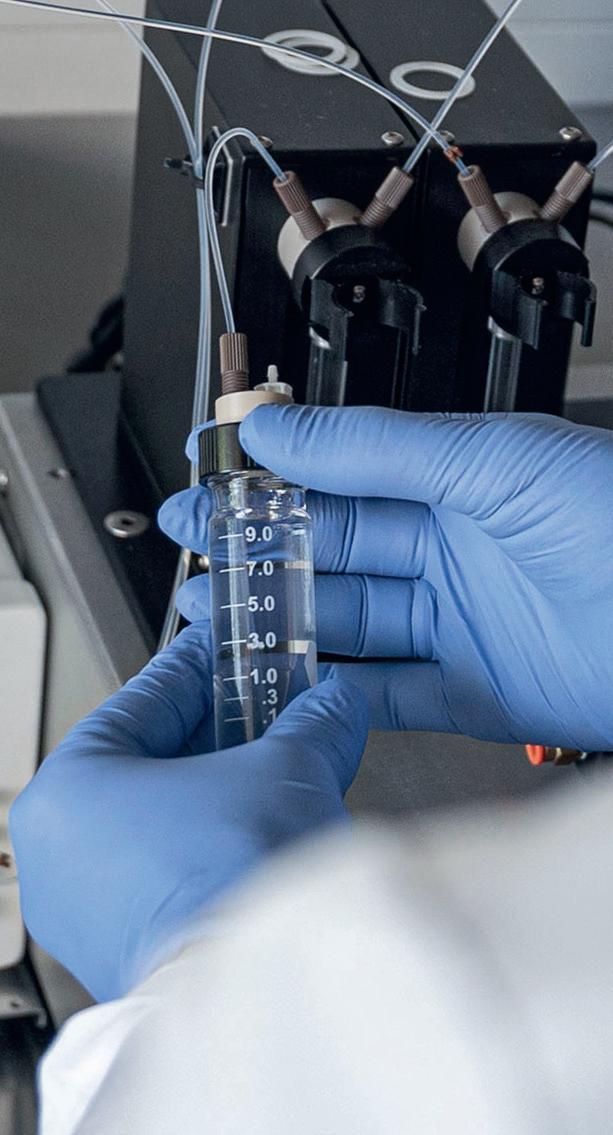
This year, Soft Flow – present in Hungary for almost three decades – celebrates five years of Danish ownership by FOSS, a global provider of high-tech analytical solutions used mainly in the agricultural and food industries. The company, headquartered in Pécs, southern Hungary, boasts the world's first fully automated multimycotoxin measuring instrument based on its own microbead technology.

Close collaboration with the mother company
Slow Flow has its own reference laboratory in Pécs. The only ‘client’ of this lab is FOSS, as Soft Flow is an exclusive partner for the mother company. “We develop solutions for commercial labs, therefore we do not have business in the field of our clients. In the development phase, the measuring units have to be validated against reference samples. It makes a lot of sense to produce these data inhouse, we have more control and more insights in this way,” the Managing Director stresses.
Universities as supply of talents
In his Diplomacy&Trade interview, the Danish ambassador to Hungary, Erik Vilstrup Lorenzen called attention to Soft Flow’s partnership with the University of Pécs. In that regard, Dr. Simon Armbruszt highlights that they have two key strategic partners in Hungary: the University of Pécs and the Agricultural Biotechnology Research Institute of the Hungarian University of Agricultural and Life Sciences in Gödöllő. “First of all, it is a huge pool for the supply of talents. For this reason, we have established an external department at the Faculty of Science in Pécs, and we are also involved in the education program of chemists and biologists. Another area of the collaboration is that there are some biotech services where we simply need external partners, because it makes no sense to make large investments for certain measurements. We also use the animal facility of the university, though here, we made big steps to develop animal-free methodologies. We are relatively independent in the field of research and development, we do not require the involvement of external resources, but there are some early phase feasibility studies or methodological side tracks where we are happy to involve academic research groups in the work,” the Managing Director concludes.
Regarding developments that have occurred at Soft Flow in the past five years with FOSS being the owners, the company’s Managing Director, Dr. Simon Armbruszt highlights to Diplomacy&Trade that Soft Flow was a purely biotechnology research and development company at the time of the 2016 acquisition. “Today, this field is still the most dominant, but since then, our activities have covered all the disciplines needed for analytical instrument development. In addition to the basic immunoassay development profile, we are now equipped with all the state-of-the-art binding agent development techniques. For this, we have built a very strong molecular biology team and we brought microbiology into our activities as well. Our analytical procedures are no longer focused solely on the flow cytometry platform, but we have developed a number of other detection platforms. In terms of application, mycotoxin analysis remains a central area, where our market solution is now available: the MycoFOSSTM is the world's first fully automated multimycotoxin measuring instrument based on our microbead technology. The process has so far been validated for wheat and maize
and will be extended to a number of additional food and feed matrices in the coming years.”
He adds that it is also a major achievement that they have set up a reference laboratory where they can help the development of new instruments with accredited level validation measurements. “In addition to biotechnology, we have also built up a very strong team of software developers who are involved in the development of various new instruments, either as front-end, back-end, or embedded developers. And the great novelty of 2021 is that we have also become involved in hardware development. For now, we only have a small but already very competent team of mechanical, electrical and simulation engineers.”
New center of excellence
Early this November, Soft Flow inaugurated a new center of excellence in Pécs. Talking about the significance of this new center in the life of the company, the Managing Director points out that their previous lab was also biosafety level licensed and they could perform genetic research, but the entire infrastructure was very outdated and they have used every square inch of it. “In
the new building, the biotechnology research and development will be implemented on almost twice the floor area, at a far higher standard. And we also have new lab units that haven’t existed before, such as dedicated microbiology laboratory, lateral-flow laboratory, hardware and software laboratory.”
Smarter management of mycotoxin risks
Soft Flow is a leading biotechnology firm in the field of the development of food and feed safety analytical solutions. As to where consumers can encounter the company’s ‘presence’ when they purchase food items, for instance, Dr. Simon Armbruszt explains that, the MycoFOSSTM solution released in March 2021, and which is hitherto the only solution that combines Soft Flow biotechnology with FOSS engineering, provides smarter management of mycotoxin risks in the grain industry. For grain producers and flour millers, protecting consumers from the harmful effects of mycotoxin contamination is of utmost importance. “The fast, accurate and reliable results we provide make it easier for producers to check contamination levels and match international food safety requirements. For feed millers, the threat of mycotoxin contamination of crops must be handled already at raw material intake. Using MycoFOSSTM helps them make better decisions about when to safely accept raw material, segregate products or take calculated risks when adding toxin binders.”
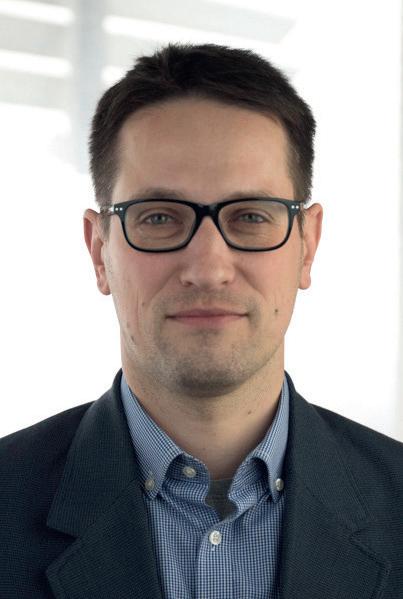
www.dteurope.com |DIPLOMACY & TRADE| NOVEMBER 2021 13 photo by MÁRTON KIRÁLY/MFAT, SOFT FLOW
danish focus
ROOF WINDOWS FOR HEALTHY BUILDINGS
THE SUSTAINABILITY STRATEGY OF VELUX AIMS AT PRESERVING NATURE FOR FUTURE GENERATIONS
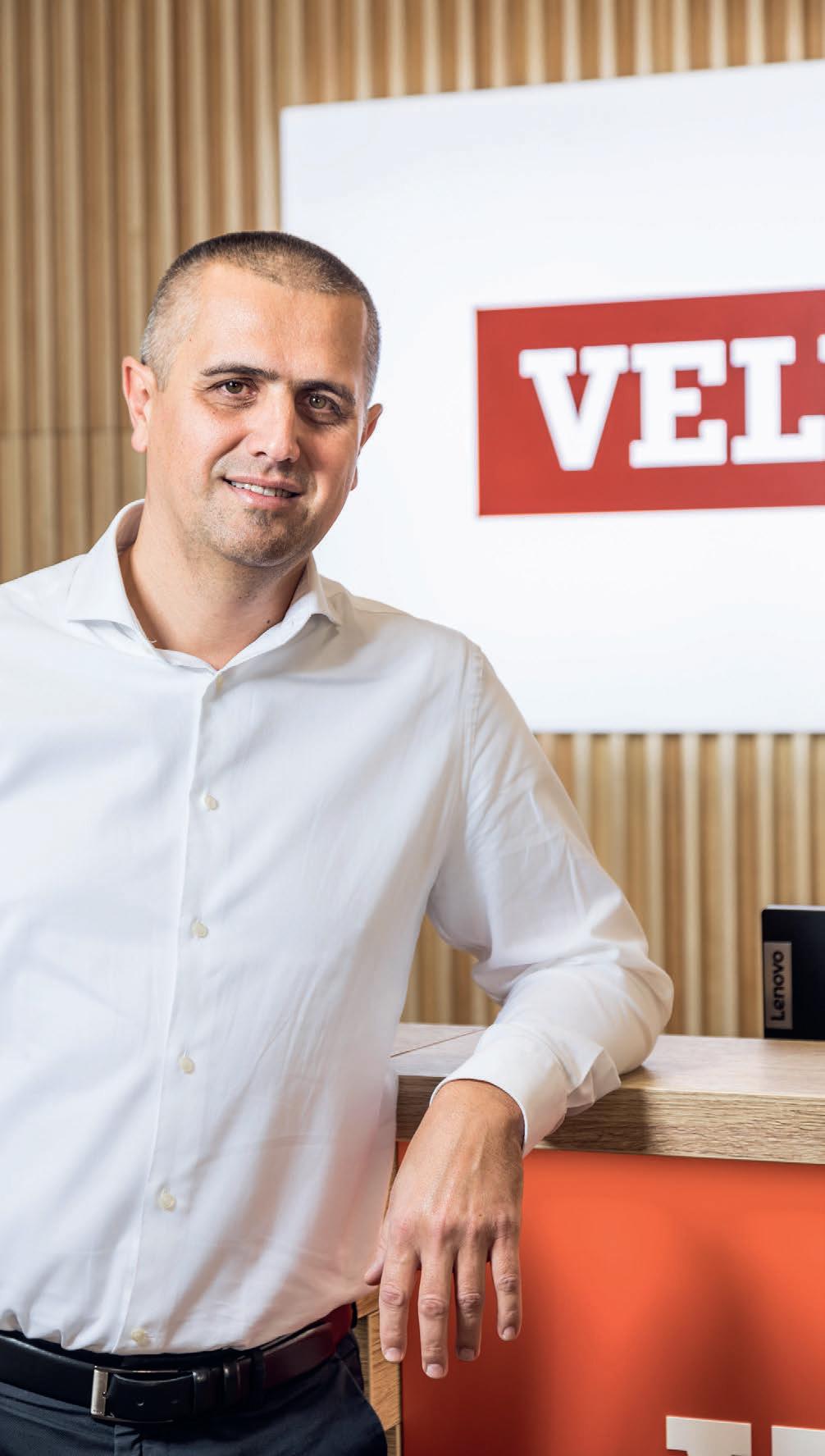
VELUX, a Danish manufacturing company that specializes in roof windows, skylights, sun-tunnels and related accessories, has had its products available in Hungary since 1986 and it was also 35 years ago that the local VELUX firm (now VELUX Magyarország Kft.) was registered here.
Explaining to Diplomacy&Trade, how the management – and the global company, which celebrates its 80th anniversary this year – evaluate these three and a half decades in Hungary, Krisztián Mészáros, Vice President Region Central and Eastern Europe since September 2020, says that “if I had to summarize it in one word: SUCCESS. VELUX was the first Danish company establishing a factory in Hungary in 1986 (actually one of the first Western European companies at that time) and it is still amongst the largest Danish companies in the country. In the past 35 years, the company developed rapidly and by now, it is one of the largest and most complex factories in the CEE region, located in Fertőd and Fertőszentmiklós, NW Hungary, producing almost all components of our products and also assembling a significant variety of finished goods. The factory is considered one of the largest employers in the northwestern part of Hungary, providing jobs for more than 1,200 people.” The company also has an office in nearby Sopron and two offices in Budapest – including the newly opened VELUX Regional Head Office in the city center that connects business management, marketing and PR communications, business development, finance and logistics functions in 14 CEE countries and support many global activities as well.
Preserving nature for future generations
VELUX has its own sustainability strategy. Regarding the main guidelines of this strategy and how the company wishes to achieve carbon neutrality by 2041, the 100th anniversary of the company, the Vice President highlights that ‘Lifetime Carbon Neutral’ is a concept initiated by the VELUX Group and developed together with WWF International to take responsibility for both past and future carbon emissions. The partnership aims to capture a total of 5.6 million tons of CO₂ through forest conservation projects around the world – the equivalent of the VELUX Group’s total historical emissions from 1941-2041 of 4.5 million tons of CO₂, plus 25% safety buffer. An integral part of this commitment is preserving invaluable natural forests, nature, and wildlife around the world for current and future generations.
“By 2030, we aim to be carbon neutral in our own operations and we will reduce the CO₂ footprint of our products by 50% and by 2041, to our 100th anniversary, we will have captured our entire historical carbon emissions dating back to our founding in 1941. Then, and only then, will we become Lifetime Carbon Neutral,” he points out.
Collective change needed
Carbon neutrality was also one of the main issues at the recent COP26 climate summit on Glasgow where VELUX actively participated. For instance, the company had a speaker at the ‘Business panel discussions on commitments to reduce carbon emissions’. Krisztián
Mészáros stresses that the building industry is responsible for over a third (38%) of the world’s entire CO₂ emissions and contributed to record breaking CO₂ emissions in 2019. “From what we can see, emissions are likely to keep increasing unless we can collectively change. Being part of the solution means identifying ‘what will drive the most change?’ For us, at VELUX, this means equally prioritizing the climate and nature crises. What participants brought to COP tables is important, but what they take away to enact upon is of greater importance. We saw some positive signs with more than a hundred world leaders promising to end and reverse deforestation by 2030. We particularly welcome this recent pledge by world leaders. At VELUX Group, we are already contributing to conserving and restoring forests through our unique 20-year partnership with World Wide Fund for Nature (WWF). Our first forest regeneration project is in Uganda’s Albertine Rift and when implemented, it will capture approximately one million tons of CO₂.
Giving back to society
Speaking of the corporate responsibility policy of the company, the Vice President says that “at VELUX, we find it very important to give back to society. We support these activities mainly through the VELUX Foundations, and also by the local companies. Altogether, the Group’s foundations give back major part of the profit to the society. One of the examples of that type of activity was when VELUX Magyarország Kft. (VELUX Hungary) supported the construction of the IndaHouse Hungary Volunteer and Children's Center in 2018 with 12 pieces of VELUX roof windows, which were installed by colleagues, professionals and partners in a voluntary program. A similar example is when VELUX Hungary replaced old skylights with new ones in the temporary children's home of the Fészek Child Protection Association in Érd, where mothers in difficult situations are raising their children.”
Inspiring future architects
The company’s award for students of architecture has been announced in Hungary as well. As Krisztián Mészáros explains, the International VELUX Award (IVA), which began in 2004, is a biennial award for architecture students around the world that focuses on daylight. Student teams and teachers work on projects that consider daylight as a relevant source of light, energy, and well-being. He points out that “in 2020, students of more than 3,000 student teams from 783 schools of architecture around the globe registered for the award – altogether from 120 countries. This is a really great number. At VELUX, we are constantly working to help the building industry participants to create buildings that make people's lives better and have a positive impact on our planet. Our aim with this event is to inspire future architects to consider the use of daylight, as this is one of the most important factors of a healthy building.”
NOVEMBER 2021 |DIPLOMACY & TRADE| www.dteurope.com
14 photo by TAMÁS BATA/BATATAMAS.HU
More than a roof window – Dream home in the attic

VELUX roof window Creates a larger living space to the family Provides a home full of daylight Value for money 3-layer pane roof windows providing the extremely energy e ciency Equipped with interior or exterior blinds and shutters… Wooden or wood-polyurethane coated, top or bottom operated, can be opened manually or by remote control +36 1 436 0601 vevoszolgalat@velux.com Don’t settle for less
danish focus
ensure that cleaning equipment is ready to perform whenever customers need it, with maximum performance and minimal downtime. With the help of our skilled technicians, we can maximize the long-term viability of the cleaning operation across the entire equipment lifecycle – and business moving,” Norbert Kalocsai says. Nilfisk offers three distinct service packages that provide ideal support for operations of any scale. Each package leverages the advantage of Nilfisk-certified technicians and originalquality spare parts from the company’s own warehouses, helping to control maintenance costs while safeguarding the performance, customers expect from Nilfisk equipment. With the help of a Nilfisk Service team member, customers can easily determine which Nilfisk Service offering fits their needs.
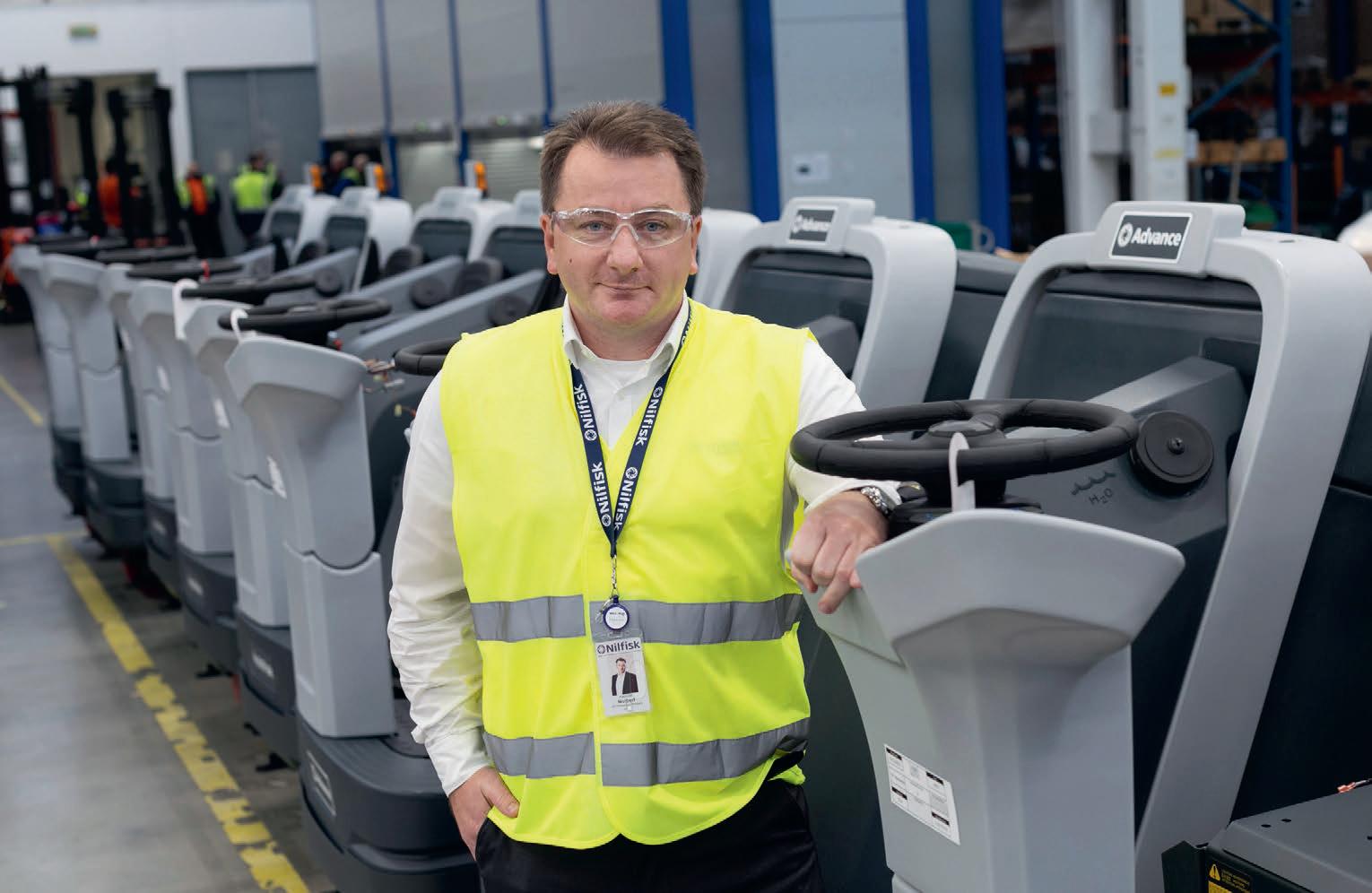
‘Service Solutions Pro’ provides professional maintenance in which contract encompasses two yearly maintenance visits and 72 hours of response time. Breakdown visits and spare parts are billed separately.
‘Service Solutions Plus’ means optimized performance. With the Plus solution, the customer has a firm grip on maintenance while knowing that machine performance is never compromised, only optimized, as we preventively cover basic consumables during the preventive visits.
‘Service Solutions Premium’ offers maximized uptime. The response time is down to 24 hours. “If uptime is absolute top priority and key concern for a customer, Service Solution Premium is the best choice.
THE PROFESSIONAL CLEANER
THE LARGEST NILFISK PRODUCTION FACILITY IS LOCATED IN HUNGARY
Nilfisk is a global leader in the field of professional cleaning equipment and full cleaning systems. The company was founded 115 years ago on a vision of producing and selling products of the highest quality worldwide. In Hungary, Nilfisk has been present for two decades.
Norbert Kalocsai, Managing Director of Nilfisk Production Ltd. explains to Diplomacy&Trade that “for more than a hundred years, Nilfisk has adapted to the changing needs of markets and customers with innovative products and solutions. With a global sales force and proven sales channels, we have established strong and valuable customer relations and partnerships across the world and we strive to be at the forefront of technological advancement to drive future customer needs. Today, Nilfisk offers an extensive range of premium cleaning products and a trusted aftermarket offering to the professional market. Our main product lines are floorcare equipment, vacuum cleaners and high-pressure washers, and a wide range of domestic vacuum cleaners and high-pressure washers to consumers worldwide. In Hungary, we are the biggest production hub for Nilfisk and producing all main platforms for the group.”
The company’s largest production facility
It was almost exactly two years ago that Nilfisk moved to the local industrial park in Nagykanizsa in southwestern Hungary and established its largest production facility there. As to why Hungary and why Nagykanizsa, the Managing Director points out that Nilfisk has a 20-yearlong presence in Hungary already. “The new site in Nagykanizsa marks a significant milestone in the consolidation of our production set-up. As a result, we today manufacture our products at fewer, but larger sites located more closely to our key markets. With the opening of a new site, we have strengthened our production footprint in Hungary as a whole, which is largely due to the talented colleagues in the region, the great network of suppliers and not least the proximity to our key European markets.”
IT Innovation and Business Support Hub
Apart from production, Nilfisk also has a shared service center here in Hungary.
Norbert Kalocsai highlights that the company’s IT Innovation and Business Support Hub was born to support value added activities within Nilfisk. “Our biggest area is IT development but other functions like, HR, Finance, Master Data and Customer Service also joined the initiative and started utilizing the talent pool, which can be found in Budapest.
Four dimensions of clean
One of the slogans at Nilfisk is ‘Cleaning is changing’. Speaking about the latest trends in professional cleaning and how Nilfisk can
keep pace with them, the Managing Director stresses that “the pandemic has led to a paradigm shift in the way we think about cleaning. Cleanliness is now business-critical for all industries, and the process of cleaning is moving from backstage to center stage.” Nilfisk has identified four dimensions of clean that define this new reality:
(1) “The new scope of cleaning: cleanliness has become synonymous with safety. No matter what segment you are in, Nilfisk can support you with the right solutions.”
(2) “Tech-enhanced cleaning: the pandemic has inspired new technologies designed specifically to tackle current challenges. The right equipment can help the effective cleaning, and Nilfisk can provide that.”
(3) “Transparent and visible cleaning: people want proof that any space they’re entering is clean. Nilfisk’s cleaning experts can provide guidance on technologies, from autonomous machines to low-noise equipment, that will help you earn trust by meeting the demands of today.”
(4) “Sustainable cleaning: as a provider of cleaning equipment, we are responsible for developing products that are even more sustainable than the ones on the market today so our customers can clean to a higher standard without harming the environment.”
Service solutions
Nilfisk does not only sell pieces of professional cleaning equipment but also provides service solutions. “Nilfisk Service Solutions help
A quarterly maintenance visit is included, and there are no sudden financial surprises.” Receiving regular service and maintenance from Nilfisk means ensuring optimal performance over the lifecycle of the cleaning machine. A service agreement maximizes and protects the value of the investment, while also keeping costs under control – increasing return on investment. The benefits include optimizing uptime with proactive maintenance, timely repairs, and effective restoration – all from skilled, experienced trained people; protecting the equipment’s value with documented service and Nilfisk-certified spare parts; and keeping maintenance costs low and predictable as well as extend the equipment lifespan.
Contribution to Sustainable Development Goals
Nilfisk is a part of the United Nations Global Compact. Regarding the measures the company put in practice to achieve a more sustainable world, the Managing Director highlights that “the United Nations Sustainable Development Goals (SDGs) provide guidance for our work within CSR, ensuring that Nilfisk works towards more sustainable development in the future.”
Nilfisk specifically contributes to SDG number 3 (Good health and well-being) to reduce illness and death from hazardous chemicals and pollution; to SDG number 12 (Responsible production and consumption) by sustainable management and use of natural resources, reducing waste generation, encouraging companies to adopt sustainable practices and sustainable reporting; as well as SDG number 13 (Climate Action) to integrate climate-change measures into policies and planning and to reduce the company’s carbon emissions.
NOVEMBER 2021 |DIPLOMACY & TRADE| www.dteurope.com
16 photo by DÁVID HARANGOZÓ

danish focus
This year, after a year's hiatus due to the coronavirus pandemic, the gastronomic awards were again decided by more than a thousand chefs, food critics and other industry players worldwide. The three-Michelin-starred Noma – run by chef René Redzepi – in the Danish capital has been in the top four times, but closed in 2016 and opened a new location in the same city two years later. The name is a syllabic abbreviation of two Danish words: ‘nordisk’ (Nordic) and ‘mad’ (food). Opened in 2003, the restaurant is known for its focus on foraging, invention and interpretation of New Nordic Cuisine.
Simplicity, freshness and seasonality

NOMA NAMED THE WORLD'S BEST RESTAURANT
TWO DANISH RESTAURANTS TOP THE LIST OF WHAT IS CONSIDERED THE OSCARS OF GASTRONOMY
Once again, Noma in Copenhagen has been named the world's best restaurant, taking the top spot in ‘The World's 50 Best Restaurants’. Geranium, another restaurant in Copenhagen came in second.
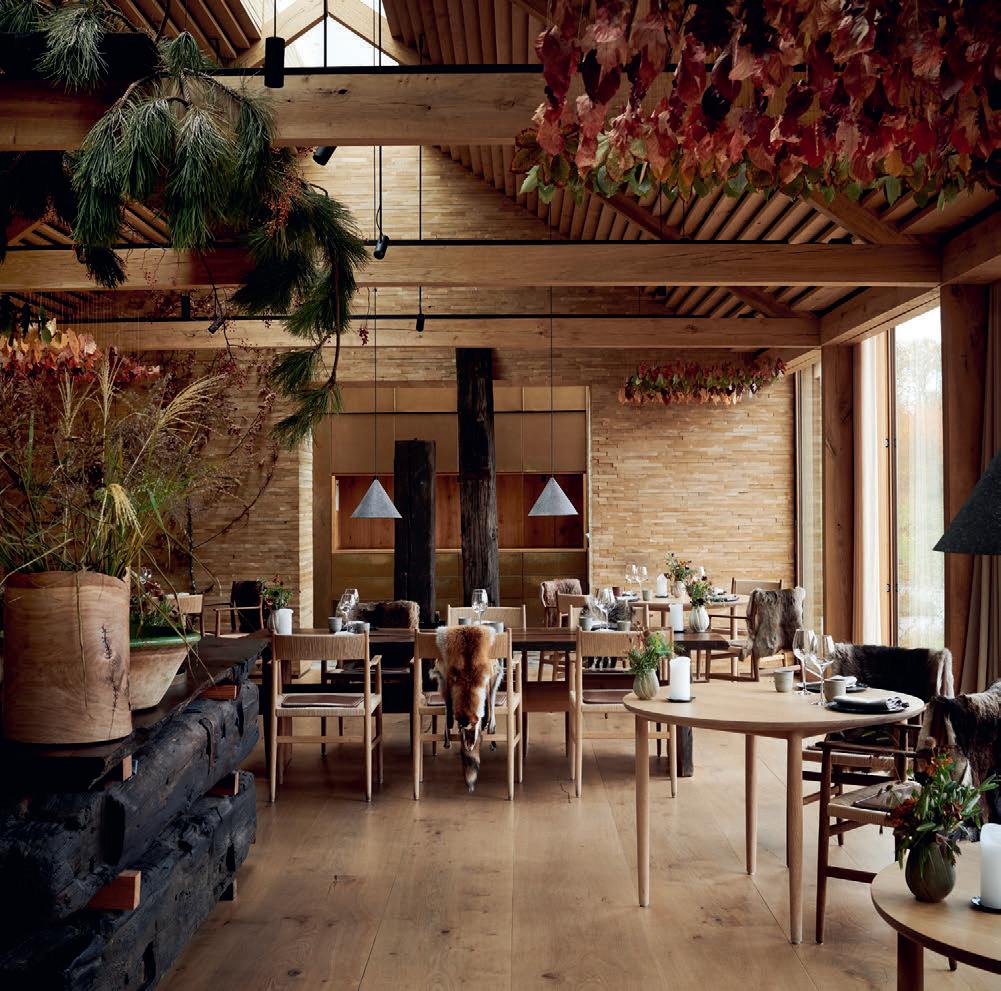
As the award website puts it, the original idea with Noma when it opened in 2003 was to challenge the Old World order of gastronomy and celebrate Nordic ingredients. The following year, New Nordic Cuisine was born with a focus on simplicity, freshness and seasonality. The concept of cooking according to season is now so common throughout the world that it has almost become hackneyed, but back then, 25-year-old chef René Redzepi and restaurateur Claus Meyer were about to change everything. The chef wanted to show the world it was possible to create something exceptional without foie gras or caviar, and that Nordic ingredients like cod liver and milk crisp could be just as special. The restaurant, housed in a waterfront warehouse in Copenhagen’s Christianshavn neighborhood, soon won critical acclaim.
Whatever land and sea provide
One of the famous items at Noma is René Redzepi’s signature dish 'The Hen and the Egg', a meal cooked by the diners themselves. It consists of potato chips, a wild duck egg, slightly wet hay, salt, herbs, wild forest plants, hay oil, thyme, butter, and wild garlic sauce. And it is not just the food itself. Redzepi pioneered the practice of having chefs cross the dining room Rubicon and serve the guests themselves. He believed that if a chef looked a diner in the eye,
it would help them to understand the true point of dishes such as the elegant Flower Pie. Noma offers three menus at different times of year, with seafood season from January to June, vegetable season during the summer and game and forest in the winter. The restaurant closes before each season so that its R&D team, led by Mette Søberg, can develop new menu items from whatever the land and sea provide.
Return to Denmark
After more than a decade of Noma, Redzepi felt that routine was killing his creativity, so he decided to close the restaurant “for good” – to “dare again to fail”. He shuttered it at the end of 2016 and soon relocated his entire team to Tulum, Mexico, for a pop-up that followed similar ones in Tokyo and Sydney. He finally unveiled a new Noma in February 2018 at a different location with its own farm and three completely distinct seasonal menus. The new restaurant once again topped the list of ‘The World's 50 Best Restaurants in 2021’ – for the fifth time after 2010, 2011, 2012 and 2014 –, but it was its predecessor that forever changed the path of gastronomic history, the award website highlights.
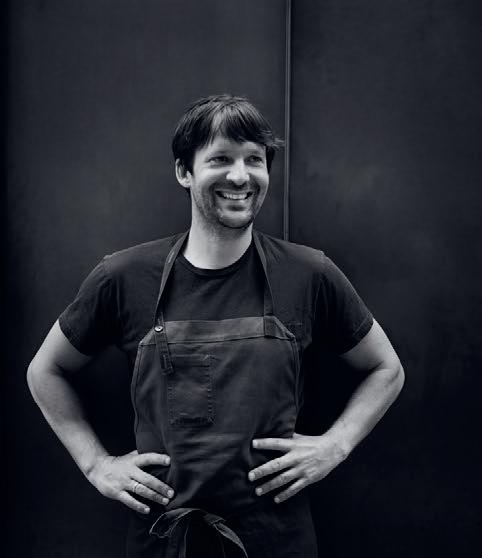
NOVEMBER 2021 |DIPLOMACY & TRADE| www.dteurope.com
18 photo by DITTE ISAGER
YOU CAN SUBSCRIBE TO OUR NEWSLETTER BY READING THIS QR CODE WITH YOUR SMARTPHONE AND FILL IN YOUR DETAILS



















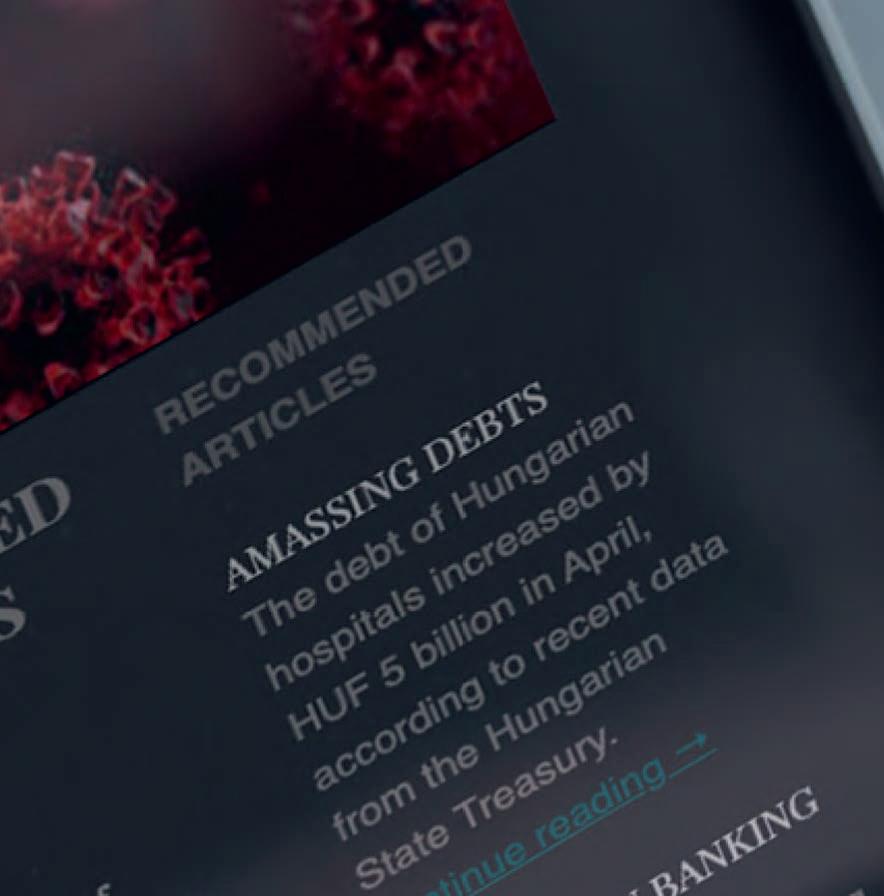
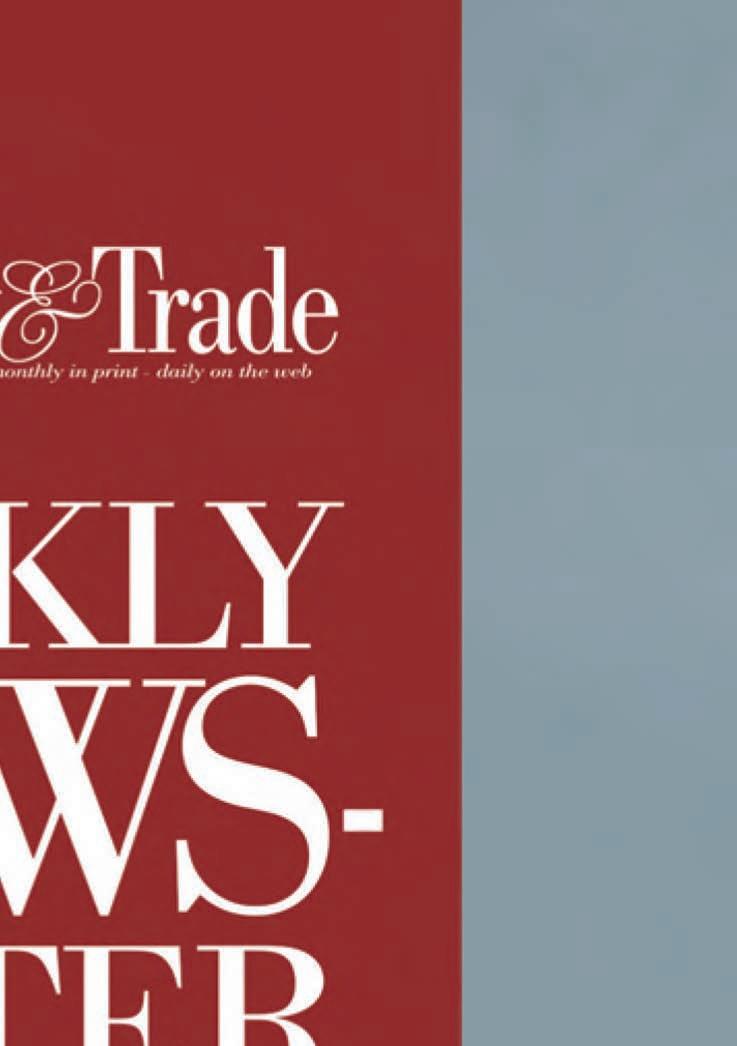
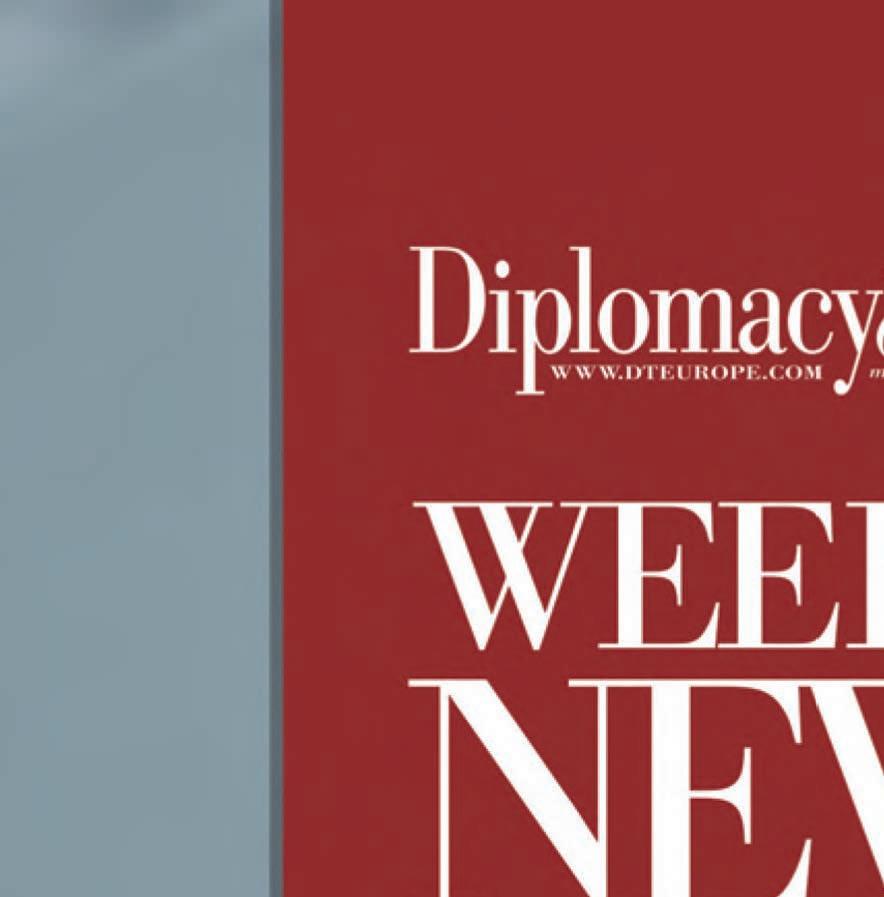

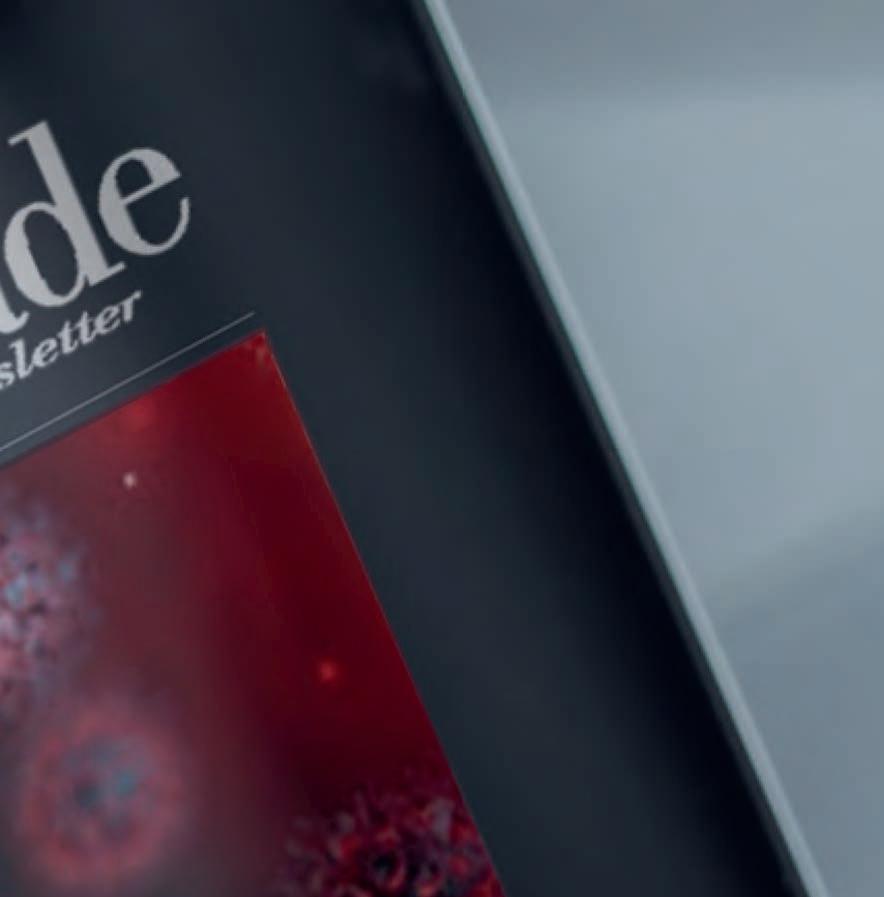
19
witty leaks
WITTY LEAKS
IN
PERSONAL
DEEPENING UNDERSTANDING&RESPECT
IRISH STUDIES ARE A GREAT WAY TO BUILD CULTURAL RELATIONS AND PEOPLE-TO-PEOPLE LINKS IN HUNGARY
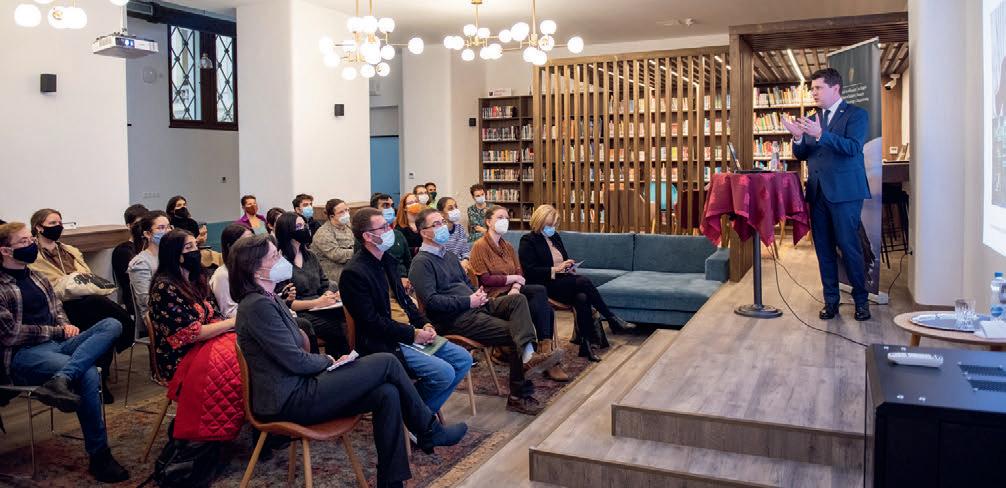 BY THE AMBASSADOR OF IRELAND, RONAN GARGAN
BY THE AMBASSADOR OF IRELAND, RONAN GARGAN

Naturally, the more of a country you see, the more you'll come to know it. This is why since my arrival in Hungary as Irish Ambassador in August 2019, I set myself the target of visiting at least one Hungarian region, town or city outside Budapest every month. While the COVID-19 pandemic has unfortunately curtailed my ability to fulfil this promise, I am delighted that in the last two years, I have been able to visit every major city and town in Hungary and far more besides.
People-to-people links
A major part of any visit to a region, town or city, in addition to calling on the mayor, the Chamber of Commerce and other economic related meetings, is to visit the University, and in particular the Irish Studies Departments, their scholars and students. The study of Irish literature, history, heritage and politics is a great way to not only gain a better understanding of Ireland but an opportunity to build cultural relations and people-to-people links between Ireland and Hungary. As the Irish Government’s Diaspora Strategy 2020-2025 states: “Irish studies programs can play a vital role in developing an enhanced awareness of Irish life and culture among the next generation of the diaspora and in the development of the affinity diaspora.” This is why I am anxious to ensure Irish Studies programs in Hungary are supported, nurtured and sustained for the next generation. Therefore, in my travels throughout Hungary
I want to recognize those institutions and individuals that do so much to keep the flame of Irish Studies burning brightly in Hungary and work to pass on the torch to a new generation of scholars and affinity diaspora. In my most recent visits to Eger and Debrecen, and in 2020, to Pécs, I made sure to meet the scholars and students in the Károly Eszterházy Catholic University, the University of Debrecen and the University of Pécs. I had the pleasure of providing a lecture on contemporary Ireland to the students at all three universities. These visits to the Universities are not only a way to connect with those interested in Irish studies and Ireland but are also an opportunity to explore the strengthening of links between universities in Hungary and universities in Ireland. Irish studies can in fact act as a conduit for building those relationships and can lead to partnerships in areas and sectors beyond Irish studies.
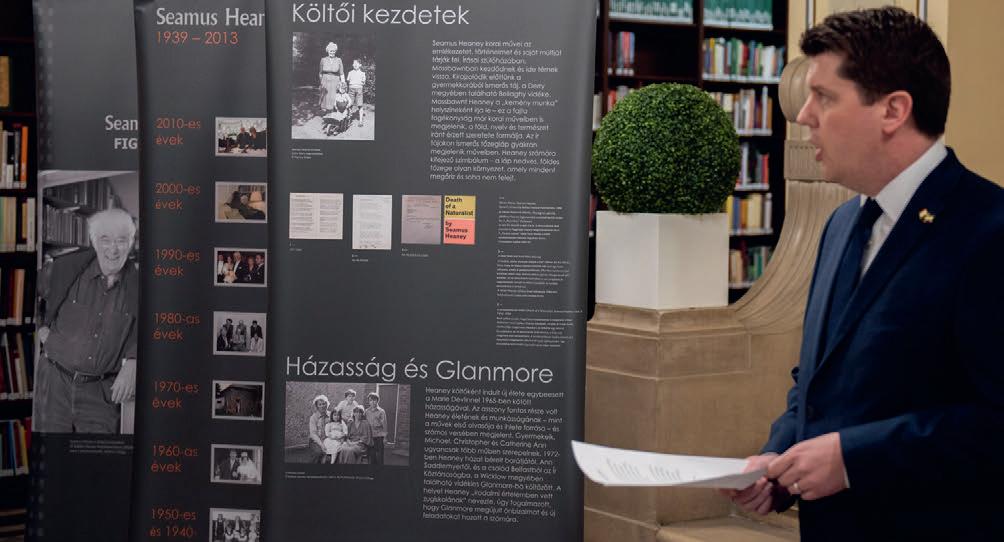
The Fifth Province
The Embassy of Ireland also plays our part in promoting and sustaining Irish Studies in Hungary. Every year, we host an Irish Studies Scholars Forum, which brings together all the universities, institutions, societies and scholars working on Irish studies and Irish culture in Hungary. This is an opportunity to gather all the activities and events happening in Hungary related to Irish studies and to encourage collaborations while also finding opportunities for the Embassy to support these activities. One such recent initiative has been the establishment of ‘The Fifth Province’, a website that brings together everything Irish studies and Irish culture related in Hungary, from events, lectures, conferences, publications and interviews, and to bring these activities to as wide an audience as possible. Cleverly, the name refers to the fact that
Ireland is made up of four provinces – Connacht, Leinster, Munster and Ulster – and now there is a virtual fifth province right here in Hungary. Anyone with an interest in Irish culture and wants to know more and even to get involved, I would encourage you to visit www.thefifthprovince.hu.
In addition, since 2014, and with the help of Irish companies in Hungary and the Irish Hungarian Business Circle, the Embassy has been running an Irish Studies Bursary Program. This program enables two Hungarian students of Irish Studies to travel to Ireland to undertake research or attend conferences or summer schools. Such a program is in recognition of those in Hungary committed to Irish Studies and such visits to Ireland will hopefully help sustain this commitment and encourage others to pursue their interest in Irish studies. Thus, we aim to sustain Irish studies in Hungary.
Promotion through culture
Of course, Irish cultural events are also an ideal way of promoting an interest in Irish studies. During my recent visit to Eger and Debrecen, I was honored to open an exceptional exhibition on the life and work of one of best loved Irish poets and Nobel Prize winner in literature, Seamus Heaney. The exhibition, entitled “Listen Now Again”, is the product of a partnership between Ireland’s Department of Foreign Affairs and the National Library of Ireland. Seamus Heaney transforms the ordinary world into extraordinary words. Few poets have captured the ear and imagination of the world like Seamus Heaney and with this exhibition, I hope that more students will be inspired to study Ireland and our rich literary heritage. The exhibition also complements the annual Seamus Heaney memorial lecture, which is organized by the Széchenyi Academy of Arts and Letters, and proudly supported by the Irish Embassy.
Literary centenary
2022 will be a big year for Irish Studies in Hungary. Next year, we will have the most important literary centenary in the history of the Irish State. February 2nd, 2022 marks the centenary of the publication of James Joyce’s Ulysses, the defining literary monument of the 20th century, and the single most influential Irish artwork ever produced. Of course, Hungary has a strong link with Ulysses. The father of Leopold Bloom (or Virág, the Hungarian word for flower), the hero of Joyce’s Ulysses, hailed from Szombathely and each year around June 16, this city celebrates Blooms Day with a festival, which the Embassy has proudly supported over the years. The Embassy will be working with the city of Szombathely again in 2022, as well as with the James Joyce Society in Hungary and the Irish Studies scholars and institutions to develop a program of events throughout Hungary to mark the 100th anniversary of the publication of this seminal book in the history of modern literature.
I look forward to continuing my travels throughout Hungary and in doing so, recognizing the contribution that Irish Studies makes to deepening the understanding and respect between Ireland and Hungary and widening the opportunities to strengthen our deeply rooted ties. And, by way of a very enjoyable by-product, visiting the wine regions of Hungary and enjoying what they have to offer – of course, all in the interests of building stronger bilateral relations!
NOVEMBER 2021 |DIPLOMACY & TRADE| www.dteurope.com
20
THIS SERIES, DIPLOMATS SHARE
ACCOUNTS OF THEIR EXPERIENCES ON “EXCURSIONS” into Hungarian culture, art, gastronomy & scenery.
photo by EMBASSY OF IRELAND, TRILITE.HU
STING: MY SONGS
MARCH 16, 2022 BUDAPEST ARENA
Sting’s My Songs concert is an exuberant and dynamic show featuring his most beloved songs, written throughout the 17-time Grammy Award winner’s illustrious career both with The Police and as a solo artist. Hailed a “masterful performance from start to finish,” the concert takes fans on a musical journey through time, with hits like ‘Fields of Gold’, ‘Shape of my Heart’, ‘Roxanne’ and ‘Demolition Man’ punctuating an unforgettable show. Fans can also expect to hear ‘Englishman In New York’, ‘Every Breath You Take’, ‘Message in a Bottle’ and many more.
On tour, Sting will be accompanied by an electric, rock ensemble including Dominic Miller (guitar), Josh Freese (drums), Rufus Miller (guitar), Kevon Webster (keyboard), Shane Sager (harmonica) with Melissa Musique and Gene Noble (backing vocals). The special guest of the evening is Sting’s son, Joe Sumner. livenation.hu



19TH ITALIAN FILM FESTIVAL - MITTELCINEMAFEST


NOVEMBER 6-16, PUSKIN AND TABÁN

CINEMAS, BUDAPEST
A joint event of the Italian Cultural Institute in Budapest and Istituto Luce-Cinecittà will present a dozen of the latest and best Italian films, including several festival successes, in their original language with Hungarian subtitles. The 19th Italian Film Festival will open with Mario Martone's ‘The King of Laughter’ (Qui Rido Io). Set in the Naples of the Belle Époque at the beginning of the 20th century, the film follows the life of the great comic actor Eduardo Scarpetta (played by Toni Servillo) whose life was the theater.
‘Inner Cage’ (Ariaferma – directed by Leonardo Di Costanzo) also stars Toni Servillo. A dozen inmates, accompanied by a few prison guards, are waiting to be transferred to their new place. In this tense atmosphere, the rules of segregation are being broken down... ‘Latin America’ (America Latina) is directed by twin brothers Damiano and Fabio D'Innocenzo. The polite and calm Massimo is a great dentist who has achieved everything in life that a man could want: material wealth, a nice family, a balanced life. But one day Massimo goes down to the cellar... Pietro Marcello, Francesco Munzi and Alice Rohrwacher collaborated on ‘Futura’. On a long journey through Italy, we discover how young people aged between 15 and 20 imagine the future.
‘A Bookshop in Paris’ (Il materiale emotivo) is about Pierre, a Parisian antiquarian whose life revolves around rare books and his paralyzed daughter, until he meets a frank, vivacious woman. iicbudapest.esteri.it
CÉZANNE TO MALEVICHARCADIA TO ABSTRACTION
OCTOBER 29, 2021 – FEBRUARY 13, 2022 MUSEUM OF FINE ARTS, BUDAPEST





Nine years after the hugely successful exhibition Cézanne and the Past: Tradition and Creativity, the Museum of Fine Arts, Budapest hosts another show linked to Cézanne. It explores the connections between the œuvre of the French master and French Avant-garde art from 1906 to 1930. The exhibition takes a new approach to Paul Cézanne’s œuvre by looking at points of connection between the French master and several important classical Avant-garde artists. While Cézanne and the Past in 2012–2013 focused on the meeting points between the great predecessors (e.g., Michelangelo, Giovanni Lorenzo Bernini and Nicolas Poussin) and Paul Cézanne’s works, the new exhibition examines the constructive artistic trends that emerged in the first half of the twentieth century.
Besides works by Cézanne, visitors can see those by masters of De Stijl (Piet Mondrian, Theo van Doesburg and Vilmos Huszár), Russian Avant-garde artists (Kazimir Malevich, Aleksander Rodchenko, Antoine Pevsner and Mikhail Larionov) and artists who participated in the Bauhaus (Paul Klee, Lyonel Feininger, László Moholy-Nagy and Sándor Bortnyik). The exhibition parading some 120 paintings, sculptures, drawings, watercolors and prints displays works from the museum’s own holdings as well as loans by the world’s prominent museums and private collections. mfab.hu
MÜPA TENT
NOVEMBER 30, 2021 – JANUARY 09, 2022, PALACE OF ARTS (MÜPA)


HOT WHEELS MONSTER TRUCKS LIVE


MARCH 19, 2022, BUDAPEST ARENA


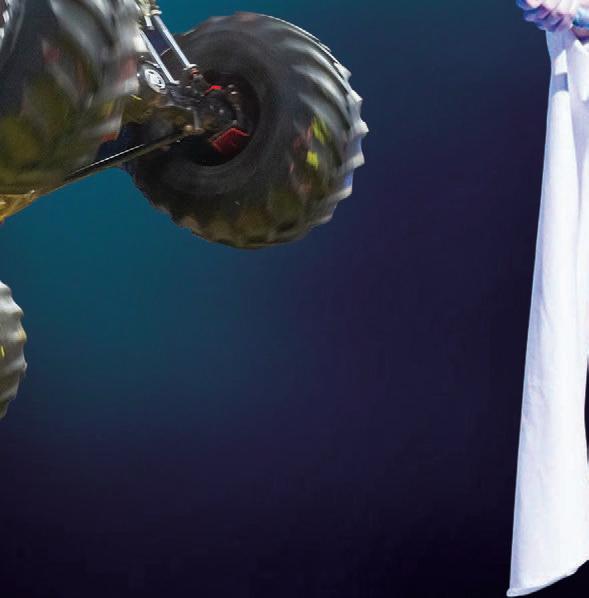
Hot Wheels Monster Trucks Live returns to Europe, with more trucks than ever before! The allnew Mega Wrex™ truck towers with its 12-foot dinosaur design, bolstering 1,800 horsepower to crush the competition. Fans will also be introduced to the new Bigfoot Midwest Madness™, as well as Race Ace™ as a new monster truck to the event series, bearing the iconic Hot Wheels flame design. The tour continues to bring audiences the only opportunity to see real-life versions of the famous Hot Wheels monster truck toys including returning favorites – Bone Shaker™, Tiger Shark, V8 Bomber™, and Demo Derby. Event performances will also feature a special appearance from the car-eating, fire-breathing transforming robot Megasaurus, and the high-flyers of Hot Wheels Monster Trucks Live, Freestyle Motocross!
The popular Crash Zone Pre-Show Party is will begin 2-1/2 hours before every performance. The unique experience provides fans access to the competition floor to see the outrageous designs and epic size of the Hot Wheels Monster Trucks! Fans can make the day even more memorable with an adrenaline-fueled VIP Package – including amazing views of the action, merchandise, guided Monster Truck tours and more!
There will be two shows in Budapest, the matinee will start at 11.30 while the evening show at 18.30. livenation.hu

Once again this year, there will be surprising visitors with magical winter experiences in the Müpa Tent. Returning with a renewed cast will be the Recirquel Contemporary Circus Company’s amazing contemporary circus fairy tale Kristály: a huge success last year, it features acrobats sweeping above the audience’s heads at a mere arm’s length away. The Kaláka ensemble, now 50 years old and a favorite of every generation, will be there with their Advent program Nativity to help everyone get into the holiday mood. The Benkó Dixieland Band, for their part, will show everyone what Christmas in Dixieland is like. One of Hungary’s most popular singers of folk and world music, Szilvia Bognár will bring her band, the Szilvia Bognár Sextet to guide us through a concert ranging from folk to jazz, and children receptive to the genre will also get to enjoy a concert by the Kokopelli Jazz Matinee. The Hahó Ensemble’s Advent ecoparty will make the period of anticipation of the holiday an exciting one, and the soul- and funk-playing Blue Rabbit’s family show (Blue Rabbit Family) will finally give parents and children a chance to dance together. The Veronaki Band and Andi Malek and the EsZeMent MeseBand will both bring Christmas programs, the Mesebolt Puppet Theater will bring the tale of Mother Hulda to life, and the Harlekin Puppet Theater will do the same with the Jesus birth story. mupa.hu

21 photo by STING, ITALIAN FILM FESTIVALMITTELCINEMAFEST, DAVID T KINDLER, BÁLINT HIRLING, RECTO SELF-PORTRAIT/PAUL CEZANNEMUSEUM OF FINE ARTS www.dteurope.com |DIPLOMACY & TRADE| NOVEMBER 2021
TOGETHER FOR TOURISM
T-DAY IS AN OPPORTUNITY FOR PUTTING SPIRIT INTO THE TOURISM PROFESSION
The tourism sector has been one of the hardest hit areas by pandemic restrictions all over the world – and Hungary is no exception. Therefore, the main aim this year of the organizers of the annual informal event of this profession, T-DAY (to be held at the Marriott Budapest Hotel early December), is striking an optimistic note and putting spirit into the dedicated actors of this industry.
hotels, guesthouses or private accommodation. In Budapest, the one million nights spent by foreign guests is four times last year's figure, but 42% below the 2019 result. The other neuralgic point is the emerging labor shortage, which needs to restore the sector's tarnished reputation. This is most noticeable in the capital. “The big question is how to tackle this labor shortage...,” she says.
Strengthening the feeling of togetherness
Károly Bosznai stresses that “now that there is a possibility to open businesses again, everybody is happy to be back in the tourism sector and glad to find that finally something has started to roll, something is happening again. Things started to move towards what was normal before and for the moment, everybody would like to work again as many of these people staked their lives on tourism. Those who stayed even in the pandemic period would like to restart their business because this is their profession. Basically, we want to give them a little faith. We could see in the past few months that in line with whatever was allowed by the government and by health circumstances, people again had the desire to go to restaurant, travel, stay in hotels, receive tourism services.” People working in the hospitality and catering industry and related fields wholeheartedly welcomed this development but now, with the fourth wave of the pandemic in this country, there is great uncertainty again. The situation is especially perilous for those who are using the last reserves to keep afloat. “We would like to reinvigorate these people that ‘yes, we are here, we are doing it, we are together’, strengthening the feeling of togetherness in the profession as there has not really been an occasion recently where all these people could come together in such a relaxed format. Since there was great need for such an event in the past, we feel that people now are really hungry for such a gathering.”
Sustainable event for a sustainable sector


The main mission of T-DAY is to provide a networking opportunity and meeting point for tourism operators in a stylish environment, in the form of an informal evening reception. T-DAY is a meeting place for people working in the tourism industry (hotels and catering, travel agencies, event management companies, airlines, car rental companies and other tourismrelated professionals) who want to meet new colleagues and new business partners.
Inspiring people
The first T-DAY debuted in March 2010 as the official after-party of the Travel Exhibition in Budapest and has since become a regular annual networking forum for the tourism industry. As one of the organizers, Károly Bosznai, the owner of the T-DAY brand, recalls, “the basic idea was to organize a casual event for the tourism industry where the representatives of the sector can be together in a relaxed atmosphere. The tourism sector is very versatile and we wanted to provide these people with an annual meeting point. Last year, on the last Thursday of February,
we could still hold the event before the pandemic but it was not the case this year. In the past one and a half years, we felt a strong pressure from tourism professionals to do something, to organize something to inspire people and motivate the colleagues.” He adds that in addition to creating a meeting point, “T-DAY would like to provide opportunities with our modest means for people working in tourism to exchange ideas and opinions to talk and think together about how to forward the cause of Hungarian tourism. That is reflected in our motto ‘Together for Tourism’. A lot of people have left this industry recently. Fluctuation was not uncommon even before but now, this process has strengthened under the pandemic restrictions, Thus, we would like to create a positive atmosphere to ensure them that they are not alone.”
Closer destinations
The head of communication at T-DAY, Krisztina Henyecz agrees. “It is very important to strengthen the notion of togetherness within the tourism sector. We can achieve a lot more and a lot of success by joining forces than by

individual efforts. I believe that this event is unique because again this year, it will make it possible for professionals in the industry to have easy-going chats, get to know each other and by using synergies, they can work together and create something new.”
She believes that a lot of Hungarians are planning to travel but are likely to stay within the country and thereby strengthen domestic tourism. Lake Balaton, the hills Mátra and Bük, the spa region of Bük and Sárvár, Sopron and Lake Fertő near the Austrian border as well as Budapest are still popular destinations. “We can say that by October this year, tourism in the countryside reached its 2019 pre-pandemic level with domestic traffic resulting in two million overnight stays in accommodations outside the capital, up 35% from a year earlier, even up 2% on the record year of 2019.”
She explains that quality accommodation and hospitality facilities and attractions await guests, a process that will be helped by mandatory accommodation certification from 2022, which will provide a compass and benchmark. The aim of the rating is to ensure that guests receive reliable quality in all types of accommodation, be it

According to Krisztina Henyecz, more and more places of accommodation and catering strive to make their location as sustainable as possible and work in a ‘green’ way. Therefore, it is now becoming an expectation from higher management and guests alike that they require the consumption of food and drink in an environmentally friendly way and leave less harmful footprints. “We also wish to follow such guidelines and organize this T-DAY event based on such principles. We have an initiative to join forces with the MyForest community forests foundation, which means that part of the proceeds from this event will go towards purchasing trees that will then be planted, therefore contributing to the enlargement of green areas in this country. Also, we suggest that people arrive to the event with public transport, there will not be too many leaflets, we try not to use plastic tableware as much as possible, not use plastic straws but recyclable ones – this is what we pay a lot of attention to.”
Károly Bosznai concludes that “at this gathering, we will prefer purchasing from local businesses so that the focus is centered on domestic products, restaurants and other service providers – the event will be based on the ‘farm to table’ concept. We try to be sustainable in basically all elements.”
NOVEMBER 2021 |DIPLOMACY & TRADE| www.dteurope.com tourism 22 photo by DÁVID HARANGOZÓ
THE MOST POPULAR HUNGARIAN WINES IN 2021
VILLÁNY AND SZEKSZÁRD DOMINATE THE REDS WHILE TOKAJ IS UNCHALLENGED IN THE SWEET WINE CATEGORY

from Villány and Szekszárd. There are only two regions where Bikavér (a.k.a. ’Bull’s Blood’) production is permitted: Eger and Szekszárd, and though the blending regulations are different which opens the door to quite divergent styles, Bikavérs typically show a distinctive, spicy and fruity character. Eger’s St. Andrea Vineyards and Winery has not only won the popular vote for the best Bikavér with its 2017 Merengő but also came first in the ‘Best Wine Bar and Wine Restaurant’ category thanks to the St. Andrea Wine & Sky Bar.
Clustered around grape varieties
The public votes revealed an interesting tendency: among white wines the winners clustered around grape varieties as opposed to wine regions. In the Great Hungarian Plain, it was the 2020 Irsai Olivér by the Frittmann Brothers’ winery that won hands down, in Etyek, the crowd’s favorite was Etyeki Kúria’s 2019 Sauvignon Blanc. In Hungary, when you say ’rosé’ it is Szekszárd that comes to everyone’s mind first. This year, it was Lajvér Estate’s Prémium Rosé 2020 that took the first place.

Villány and Szekszárd dominate reds
Among reds, it’s still Villány and Szekszárd that holds sway. Vylyan’s Mandolás Cabernet Franc Selection 2016 earned the top accolade in its category. A. Gere Winery’s Solus Merlot 2016 has won the admiration of consumers with its saline, mineral, fruity notes, which are supplemented by sweet, spicy flavors. Among Cabernet Sauvignons, it was the Vesztergombi Winery that came out on top with its 2017 Szekszárdi Bodzás Cabernet Sauvignon, while in the Kékfrankos category, it was the 2016 Takler Estate Szentahegyi Kékfrankos that triumphed.
This was the first occasion that the Vince Awards were presented to the best representatives of the Hungarian wine scene. Both wine professionals and members of the public were involved in the voting process. Among the favorites of wine lovers, you will find wineries, wines, restaurants, wine bars and wine stores. The winners’ list includes not just high-end wines but also entry level items with outstanding quality.
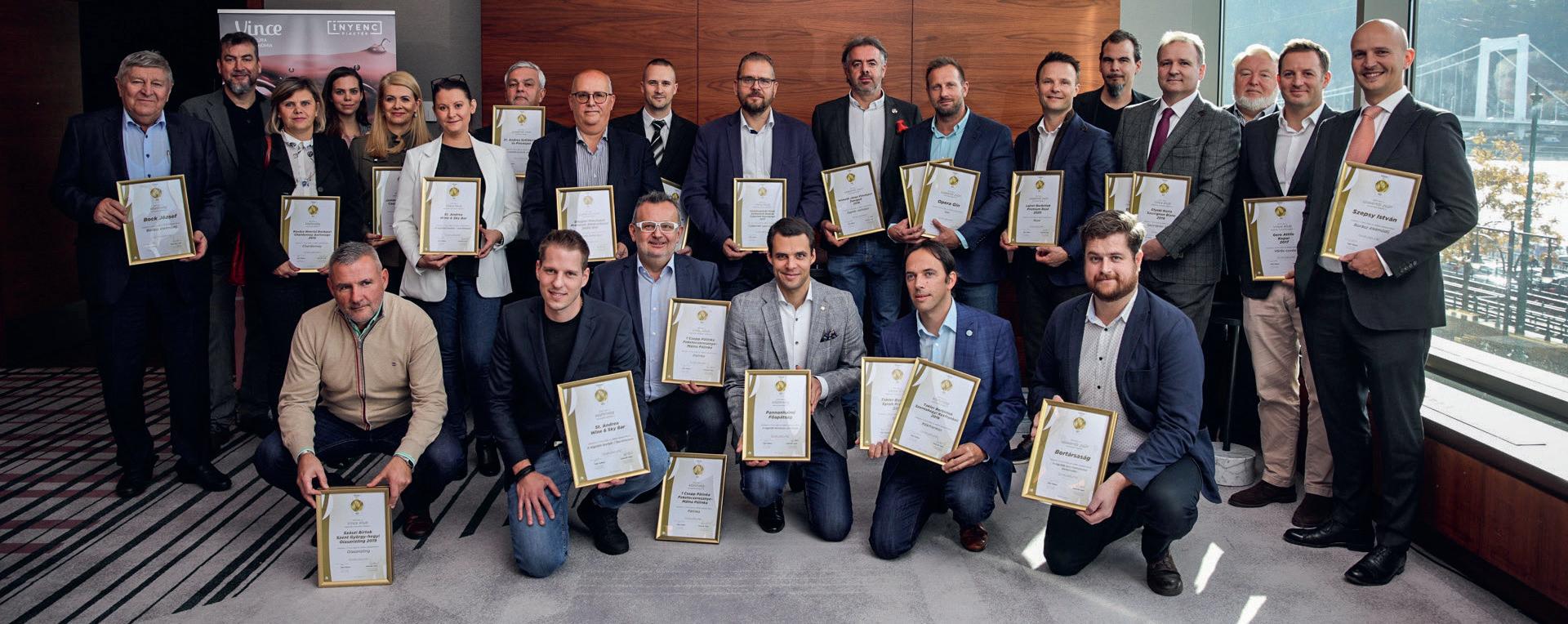
Bikavérs with character
The results of the public vote clearly show that in customers’ minds there is a strong link between the best-known Hungarian wine regions and certain typical grape varieties: most of the Furmint and Hárslevelű poured in glasses comes from Tokaj, while fuller, weightier reds come

Sparkling and natural Barely seven years have passed since the first bottles of Kreinbacher sparkling wines were produced in 2014 and by now, they are firmly established as crowd favorites in Hungary. Their Brut Classic has trumped all other contenders both among members of the jury and the public. In the ‘Other sparkling wines’ category the top award went to Etyeki Kúria’s Pláne Frizzante Rosé.
In the ‘Natural sweet wines’ category, Tokaj’s dominance is unchallenged. There was no debate either among the professional judges or members of the public that the crown in this category belongs to Szepsy Winery’s 2013 ‘6 Puttonyos Aszú’. The pride Hungarians take in the Tokaj wine region and its sweet wines is well justified as Tokaj Aszú is one of the most distinctive and widely respected sweet wines of the world. Hungarian wine lovers hope that with time, it will break out from the confines of the ‘Festive Period Wine’ category and becomes something precious that is enjoyed all year round.
www.dteurope.com |DIPLOMACY & TRADE| NOVEMBER 2021 23 photo by VINCE, BÁLINT CSIZMADIA
wine
There were a number of surprises in the audience vote for the Vince Awards for the viticulture industry and its related sectors. The winners of the 33 categories were announced at the Vince Gala.














































































































 BY TAMÁS MAGYARICS
BY TAMÁS MAGYARICS






































































































































































 BY THE AMBASSADOR OF IRELAND, RONAN GARGAN
BY THE AMBASSADOR OF IRELAND, RONAN GARGAN































